#and they’re also a testament of how much I love my story and especially characters I think
Text
The Avatar is master of the elements, I am master of the AUs
#you know I’m not one to praise myself but I think all my aus are really good#I think I cracked the au code#I could talk about them all the time that’s how much I love them#and they’re also a testament of how much I love my story and especially characters I think#cause I’m so attached to them that I make all these aus even if some would make great separate stories#writer speaks#writeblr#wip: the knights of the alder#my love
5 notes
·
View notes
Text
What Happened to Gonzo's Queerness?
Gonzo is, undeniably, the Muppet that Disney has struggled to keep consistent and in character the most. But why is that? If we take a look at any recent Muppets projects, from Muppets Haunted Mansion, to The Muppets (2015), or even Muppets Most Wanted, Gonzo is simply a shell of his former self. An entertaining shell at that, but a shell nonetheless. Before we can get into the how and why though, I’ll explain a little bit of who Gonzo really was when featured in the Muppets of the past.
A Brief History of Past Gonzo
Gonzo’s key traits have always been that he is zany, immature, unpredictable, and often takes things far too literally. While “Modern Muppets” keeps these core traits in the Gonzo of today, he still lacks his usual depth. Often people overlook the fact that any of the Muppets have depth at all, but they’re all given their own moments, especially film to film.
I think a perfect example of what I’m talking about is his song, “I’m Going to Go Back There Someday”, from the original Muppet movie. Within The Muppet Show no characters ever struggled that much with overarching plots or even real negative emotions that carried from episode to episode. But in film where an episodic format won’t work, you need these small subtle layers. Your characters all have to have more obvious wants and needs to move the story along, or else it’ll all fall flat. This song is just a testament to the Muppets seamless transition from television to film. The number humanizes and grounds a character that is often perceived as ignorant or carefree by giving him a single wish, a wish to return to the sky like he did previously in the movie. Gonzo wants to be free from the world and view it simply as a spectator, completely at peace. It’s a childish wish, but a real and relatable one. The layers of this song can go deeper when you take into account the fact that Gonzo is the only one of his species, and probably spent most of his life alone or without a true home before the Muppets. Combine this with the fact we’re at the lowest point in the movie where all hope seems lost in the middle of nowhere, and then have all the other Muppets in the scene do backing vocals, it becomes a really somber and special moment for the movie as a whole. It connects well with Gonzo, the other Muppets, the film’s story, and audiences around the world.
Other moments that showcase this level of subtle emotional complexity can be found in The Muppets Take Manhattan during the song “It’s Time for Saying Goodbye”, or throughout the entire Muppets from Space movie where Gonzo discovers and comes to terms with his own identity and place within the world.
Muppets Haunted Mansion tried to recreate some form of a plotline for Gonzo, but because there was such little set up the pay off felt out of place. The idea was to have Gonzo briefly struggle with the idea of being alone and losing the attention of his friends, but it didn’t even really connect to any past storylines with Gonzo or even past moments within the movie, and just felt forced. Especially since he never truly grew at all from this experience either.
But depth wasn’t the only thing we lost from Gonzo in the “Modern Muppets”, we also lost so much of his queer-coding. In the past, Gonzo has always been shown as unidentifiable in both gender, gender expression, and sexuality. Some of my favorite pieces of evidence towards this include the Gene Kelly episode of The Muppet Show where Gonzo distracts Miss Piggy so he can be serenaded by Gene Kelly. Gene briefly acknowledges how strange this is, but Gonzo seems unconcerned and so the two sing a love song together and all is well. Gonzo often does this, flirting with both male and female guests on the original show, as well as cross dressing throughout all five seasons of the show. Gonzo also cross dresses on the original Muppet Babies show from the 1980s, and there is even a Muppet Babies picture book from 1986 titled “What’s a Gonzo?” in which Gonzo and the other Muppets try to figure out what Gonzo is, only for Gonzo to be confronted by other versions of himself and told that he doesn’t need to know what he is because he knows who he is. Then, of course, there is also the iconic washroom comic strip from the officially licensed “Jim Henson’s Muppets” comics from 1981-1986, which I will be inserting below!

Flanderization
Flanderization is the process through which a complex fictional character’s essential traits are oversimplified to the point where they constitute their entire personality. The term’s name is a reference to Ned Flanders from The Simpsons.
While the Muppets aren’t exactly “complex”, they do have a certain level of depth like I’ve previously explained. Watering them all down to their most well known traits is what causes most problems with the “Modern Muppets”. Obviously, all new versions of the Muppets have been put through unfortunate amounts of flanderization. However, even though all the Muppets have suffered through a similar treatment, I still feel like Gonzo takes the brunt of it. This is also because Gonzo is one of the only core Muppets who has become less of a main character than before. Meaning he doesn’t actually get a lot of screen time, especially when compared to the movies from before Disney bought the Muppets.
Why is This Happening?
This answer as to why any of this is happening at all is actually quite simple; it’s not marketable! In order to rebrand the Muppets, Disney has had to take the safe approach when it comes to reminding people why they liked the Muppets to begin with. However, in trying to keep things simple as far as character work goes, we then lose that character integrity which is what makes these “Modern Muppets” feel so hollow. Obviously this did not work at all, because Disney had stripped these characters so thoroughly, they thought they could do whatever they wanted with them and no one would notice. Cough cough - The Muppets (2015) - cough cough.
So yes, while Gonzo does keep some basic sense of his personality through taking things too literally, participating in crazy stunts, and just acting pretty random, it’s such a toned down version compared to the Gonzo so many grew up with. Especially when it comes to all his queer coding, Disney is often too afraid of backlash to even put things like that into their kids or family orientated media. This could potentially be a reason why they sort of shoved Gonzo out of the main cast in everything but promo. The only time they attempted this was around 2021 with the reboot of the Muppet Babies and an episode titled “Gonzorella”. The episode was actually quite charming, and follows young Gonzo as he decides how to tell his friends he wants to wear a princess dress to their costume party. It’s a nice concept, completely in character for Gonzo, and a good message for children about how you don’t have to look how people will expect you to look all the time. It also helps to break the stigma around “boys clothes” and “girls clothes”. Still, lots of parents were very angry about this episode and claimed it was Disney’s “new woke agenda” that was turning the Muppets into something they’re not. As if the Muppets haven’t always inherently been queer-coded and a part of queer culture!
Conclusions
So, if the Muppets are being washed out to their most basic selves more and more with each new project, what does this mean for the future of the Muppets?
Honestly? Nothing good, in my opinion. The franchise has been going downhill for quite some time, but I don’t think I’ll ever come to dislike it. If you don’t like these “Modern Muppet” adaptations, then that’s more than fine. I just personally don’t see it improving anytime soon, especially since Disney so rarely puts out any Muppets content that doesn’t get canceled. If they do put anything new out, I’ll obviously be the first to watch and praise it, because I really do enjoy the Muppets a lot.
I think the saddest thing here, and the reason I made this little essay, is that Gonzo’s queer-coding will only be lost in translation the more that time goes on. At least, that’s how I see it. The backlash Disney got for that episode of the Muppet Babies is exactly the kind of thing the company is always trying to avoid, especially with the media they make for young kids on Disney Junior. I doubt they’ll ever try something like that again in Muppets media aimed for small kids. And in the family targeted content Gonzo has only become a less and less prominent character.
That being said, this is all just my opinion based on what I have seen and studied. I will always be holding out a small sense of hope though, and I will still continue to see Gonzo as a queer icon in my eyes regardless of what he does in future projects!
UPDATE: If you made it to the end of this essay YAYY!! TYSM<33 In case anyone was wondering, my next piece is gonna be about Kaz Brekker from Six of Crows and morally grey characters in general. It will not be a critique of the character or his fan base though! I don’t always hate on everything lol. However I will probably be talking about online book communities, like Booktok, so prepare yourselves for that if you plan on sticking around :3
#the muppets#gonzo#gonzo the great#kermit the frog#disney#lgbtq#nonbinary#queer#queer community#miss piggy#analysis
21 notes
·
View notes
Note
Wow that was some heavy emotional heartbreak in that chapter! I feel like there is an elephant sitting on my chest right now. My heart just hurts that bad for two fictional characters. It's just a testament to how much emotion you create with your stories. The best stories take you on an emotional roller coasters, and that's exactly what yours is doing.
I did not see that back story coming! It makes more sense now why she wants to leave so badly. JK really didn't have a choice but to let her go. This story is kind of like that famous line that goes something like if you love someone let them go, and if they come back to you, they were meant to be yours. That's what will happen with the two of them here. He even says it one of the lines. That he'll let her go to find her own happiness, and if she comes back to him, that means she chose to be with him. By convincing her to stay in the company, it's not her choice to be with him. She's not being given any other choice that way. She has to want him on her own. And him too. He has to want her outside of just needing her to be his assistant. They need to be more to each other than what the job allows them to be.
I really hope Mr. Ri gets his chance to be with OC's mom. If OC and JK can get their "second" chance, I hope Mr. Ri does too. He's such a great character, and I've really come to adore him. I hope that when the story ends, he also gets his happy ending.
I'm assuming there will be some kind of time jump coming up in the next chapter. I would imagine it would take maybe a few years for her to find what she's looking for and make her ready to come back to him. It certainly can't happen in a few months. I'm curious to see if they stay in touch after she leaves, or if there is just a complete break between them until she's ready to find him again. The real question is will JK have gone back to his playboy persona again. Can he stay celibate while he's waiting for her? I hope so, because that would just prove to her how much he cares for her. And will she stay celibate? So many questions I can't wait to find out the answers to!
Hiii ugh, I love it when you guys cry but I always hope you feel better right after. 🥹 I cried writing this chapter, too, especially the narration of the past, so I'm happy to know that the emotions I felt are also being felt by the readers.
I've been hinting that connection from the beginning! You might spot them after another read through hehe but true, it was just so important for OC to do this for herself. Imagine having to carry that burden... And she didn't even expect to like him! Like she said, she wasn't supposed to care that much. We at least have a JK who understands why she's doing it, but sometimes the best decisions don't make us happy (right now). And that' just how life goes. Like you said, it has to be their choice, an idea that I emphasise moving forward bc choice is what OC didn't feel she's ever really had, so if she stayed for JK, she's essentially letting him take that away from her this time. It's just not a good start.
I love the love for Mr. Ri! I absolutely enjoy creating characters like this. There's so much wisdom and pain and I just like the idea of how he's family to both OC and JK. 😌😌
Hmm interesting take about the way forward. I'd say that learning to heal and finding their happiness is important but like a lovely friend pointed out, they aren't together... They just admitted their feelings but there's nothing else beyond that. Whatever feelings they have for each other haven't fully developed yet, so they don't even know what happiness with each other looks like. Sure they have their own issues, but they’re issues that intensified bc they’ve been dealing with them in their own.
Just a thought, bc this seems to be a popular take! And my answer would be... things will be happy but they won't be perfect. There are also plans for season 2, so there’s that!
Thank you so much for reading! Been enjoying reading all of your lovely thoughts 💕💕
7 notes
·
View notes
Note
Hi! I thought it would be fun to invite some peeps to share a lil about themselves if they so desire. Absolutely feel free to delete this without a second thought! ☺️ But if it pleases the jury…
What do you like to do most on tumblr — write, draw, read, etc?
Any favorite fics, with a tiny summary and why they’re so good? It’s ok if it’s your own! 😜
Three of your favorite blogs to follow and why?
Favorite SW character and why?
Ok, I suppose I’m done interrogating. 🤓 Toodle-oo!
Hi Free! Thank you for the questions :)
What do you like to do most on tumblr — write, draw, read, etc?
I like to read other people’s works, look at artwork (because I can’t draw and I’m always so impressed by those who can), and I like to write.
Any favorite fics, with a tiny summary and why they’re so good? It’s ok if it’s your own! 😜
I have read some amazing long fics and one-shots, but I’m not going to mention any. I’m always concerned I might hurt someone’s feelings, and I don’t want people to think their fics aren’t worth the time if they’re never recommended in something like this. :) (If you’re actually interested in what I’ve read, you can check my tags “drabble recs” and “fanfic recommendation”.) So, I’ll mention the fic I’m currently writing as it’s been therapeutic and allowed me to work through some of my personal issues.
Three of your favorite blogs to follow and why?
Every blog I follow is unique and amazing. To pick only 3 is tough, but here we go:
1. (@dystopicjumpsuit) DJ has written such incredible short and long fics that deal with genuinely raw and human emotions, feelings, experiences, and insecurities. I love the variety DJ has written (seriously, you can find a fic/ one-shot for any itch), and their blog has so many diverse stories and even drink recipes (I don’t drink and I’m fairly mediocre in the kitchen, but I’ve wanted to try some of DJ’s recipes because they look so fun).
2. (@starstofillmydream) Molly has written a seven-part (and ongoing) series of Commander Cody headcanons. Cody is one of my favorites and I love how niche yet realistic these headcanons are. I also appreciate the discourse and nuance Molly brings to Cody’s character, especially since she appreciates his character as the individual he is rather than devaluing him to a relationship status.
3. (@freesia-writes) I have to mention you (Free) because I enjoy seeing the chains you start. The engagement you bring to this community is positive and inclusive and it’s such a refreshing breath from some other fandom communities I’ve encountered. From your writing of so many clones, to the fun drabbles you do, I love what your blog offers the community.
Favorite SW character and why?
This one is hard because I have two: Wolffe and Thrawn.
Wolffe was the first SW character I truly came to love. His sarcastic, easily irritable personality, along with his stalwart loyalty, sheer intelligence, and strategic mindset (and his general badass vibe!) easily make him the SW character I have so much appreciation for. But the thing that made him stand out to me: in one of the comics, Wolffe gives a group of deserted clones an opportunity to prove themselves loyal rather than be punished for desertion. I’ve always thought it was a testament to his emotional intelligence and true leadership that he was willing to give these men an opportunity to regain his trust and loyalty. Wolffe is that type of character with a gruff, rougher exterior but deep down is emotionally driven to protect his brothers. And I think it’s admirable of him. I know we have minimal canonical information about him, but I love his character so much.
Thrawn is one of those characters I never expected to like but he forced himself into my life and I can’t go back. (I have to clarify, I am talking about Zahn’s Thrawn, not Filoni’s.) Thrawn in the Ascendancy trilogy brought so much nuance to his character. I like how he helps other characters reach their full potential, and is always challenging others to be the best version of themselves. He has this urgency to protect his people but also his galaxy, and the way he gets righteously angry with the enslavement and destruction of species in his part of the galaxy, along with his decisions to help these people, even when it means invoking the frustrations and dislike of leaders against him, makes him such a fascinating character to me.
10 notes
·
View notes
Note
Hiii I finally had some time so I thought id give you my thoughts
First the character I honestly feel the most sympathy for is kate shes the only one who hasn’t actually done something wrong. Even when she accidentally told reader about her and yelena its clear that wasnt done with malicious intentions, and it must be so hard for her to be around someone she loves as much as she is. Especially because yelena dropped her the second reader came back into her life like that sucks so bad.
I am so surprised no ones been into wanda this whole time cos that woman is a catch. I wonder if peter will tell wanda that valkyrie asked about her I don’t think wanda will go for it at all but I don’t think she’s gonna notice. In fact i have a funny feeling readers gonna find out about this little crush before wanda does. Not much to say on this yet as its early days but looking forward to see how this develops.
Very proud of wanda setting boundaries by not replying to reader after shes making progress and its really great to see. The way you wrote this series is paced in such a way that the character development really gets to shine and it works brilliantly for the type of story you’re telling that is all about personal development and changing circumstances that shift your perspective on things so kudos to you. I feel like with every chapter shes making progress and its a testament to your writing :)
The twins relationship is really sweet and im glad they do the check ins not just to make sure wandas alive but just to talk that sibling bond is clearly very important to them and its nice that at least one good thing came from a very tragic incident. I think pietro is a good balance of protective and understanding at the minute its clear he’s not readers biggest fan but instead of berating wanda about it he’s supporting her which is the best thing he can do.
Wanda was not a bad wife because she couldn’t get pregnant and I don’t want to hear another word 😤. I feel so bad for her for feeling like that because it really isn’t her fault and i hope she knows that. For some people its really difficult to do and making the decision to stop trying is also incredibly difficult sometimes its just a case of wrong time like you never know miracles and luck can just come. She would be the best mom too and i don’t want to hear anyone say otherwise about that either.
And finally reader and yelena.
My first thing to say about reader specifically is what the fuck is wrong with them. Spike of pettiness so they text wanda??? Leave wanda out of it (wanda protection squad over here) but seriously it’s basically using her to make yourself feel better by essentially taking a jab at yelena it is so unbelievably petty. And im glad wanda kept the conversation brief yay boundaries. In readers defence they don’t know what wanda did but still don’t use her in this way.
Reader and yelenas make up was (as much as i hate to admit it) pretty good they talked about what bothered them and why good communication. I wonder if they’re actually going to be intimate because last time I feel like reader was hesitant.
The thing i wanted to talk about was the L bomb at the end and something yelena said that ive been saying for so long now. She doesn’t know this new reader. She knows who the reader was in the past when they were younger but they’ve both changed now and im so glad she acknowledged this cos its killing me, which leads to my second point.
The L bomb. Im not sure either of them mean it properly especially reader. From yelenas point reader is the one that got away her greatest what if. Feelings from the past resurface and thats when things get complicated because is it love now or is it the love from then that she never got to express. I’ve said it so many times but these two are not the same people and they’re slowly realising that but do these new versions love each other too? Im not so convinced.
And for reader it seems like they’re confusing platonic love or even possibly feelings of nostalgia for romantic love. They just came out a 10 year relationship now a girl from their past is offering herself up to them. Its an easy option for reader a simple choice you could call it a safe choice. Some people say love isn’t supposed to be easy some say it is im not sure which i agree with because i guess there’s points for both. To me though love isnt supposed to feel like you’ve settled for less which is how i feel about this relationship. I understand readers mindset on this an easy relationship where you won’t get hurt is safer than one of those passionate ones where you might.
This is super long so im gonna add something to a separate ask its more specific about the love thing if thats okay
-🧃
I think by now we more or less agree on most things and you really have an almost perfect grasp or how everything is going to unfold.
To answer your question, about r and yelena being intimate, it was hinted at the end of chapter 11. "Then show me".
L bomb: another perspective: when i first told my partner i love her, i uh, didnt mean it the way i do now. So basically, ppl say they love someone to make the declaration, to make the decision that moment to love them, not because it was 100% what they're feeling at the moment.
Curious to see what other questions you have :)
0 notes
Text
Notes from Soo and Adam’s talk for Terror Camp: Spring Edition
Here are my (extensive) notes from the Terror Camp talk with Soo and Adam. Even though the event only lasted a little over an hour, I took four pages of notes because they had so much that was interesting to say. The video will be available soon, but I wanted to type this up.
· Both Adam and Soo are looking great. Soo had a very interesting lamp and what appeared to be an anime poster (?) in the background. Adam was in a house with a gorgeous garden.
· First question was what job would Soo and Adam like to have on a 19th century ship. Soo said probably caulking, definitely not cooking. Adam wanted Collins’s job and being able to go into the diving apparatus under water. If not that, the captain.
· For favorite relationships on the show, Adam said Crozier and Franklin, especially their scene in Episode 3. Soo said Bridgens and Peglar, especially how people’s perceptions of that relationship changed over the series, as well as Crozier and Fitzjames, especially the Victory Point scene. Adam agreed.
· Soo also added Crozier and Hickey. Adam noted how he realized during filming that Crozier and Hickey are only alone together twice, once in the cabin in Episode 2 and then the tent in Episode 10.
· About Adam’s earlier comment about Crozier and Hickey being soulmates, Hickey was very much of the belief that the world was made for him, that he dropped out of the sky and everything revolved around him, and that included Crozier. Crozier was so many things wrapped up in one: mentor, friend, potential lover, father, mortal enemy, and someone Hickey ultimately had to overcome.
· Favorite horror films and writers: For Soo, horror is something very personal and subjective. She finds war films to be some of the scariest films (note: would love to hear Soo’s thoughts on 1917). By the classic definition of horror, Blair Witch Project, especially since she is originally from the Maryland area and Don’t Look Now, both the film and Daphne du Maurier short story (excellent choice!)
· Adam is not much of a horror person (note: like Edward Ashley). He also remembers going to see Blair Witch with his dad when he was very young and not wanting to go. He spend most of the movie with his hands over his ears and left early. Jaws also made a big impression on him, and he had issues swimming in a pool afterwards (beware the magic swimming pool shark). He commented that that’s the perfect kind of fear because it’s just real enough to be plausible.
· Both don’t really think of The Terror as a horror show
· For the fan reaction to the Terror, both are very grateful. Soo commented how the lack of marketing and attention the show initially received were heartbreaking. Adam agreed. Even though he’s not on social media, he’s seen how much people have learned about the show and the history. It’s a testament to the show’s great writing he said that it makes people want to explore. “We did become a family,” Soo said.
· Adam is also getting recognized some more now that The Terror has aired in the UK. He told a story about going out and he was wearing a coat similar to Hickey’s and someone complimented him on his performance.
· When asked about the point of no return for the show, Adam immediately said Hickey’s flogging. That was game over because Hickey could have been a great ally but Crozier made an enemy. Soo went earlier when the men did not listen to Silna’s warning that they were all going to disappear in Episode 2. On a more atmospheric note, after Carnivale when the sun goes down, there’s the sense that they’re not coming back from this.
· Soo answered one of my questions which was that the show gives more voice to its female characters than the novel and whether this was intentional from the start or if it developed over time. Soo responded that it was very important to bring out these voices and make the show fully fleshed out (pun not intended) by showing these perspectives. In a visual medium, it’s clear when someone has no voice, she said. She noted that Silna was very, very different in the book and that had to change, but she couldn’t remember Lady Jane and Sophia having much attention or any chapters devoted to them. Katie Dowd the moderator mentioned Platypus Pond, and that made Soo burst out laughing. No one likes Platypus Pond.
· Adam received a question about the literary sources he used as he built EC. There were a lot, not just Genet, including the autobiography of the founder of Greenpeace although he couldn’t remember the name on the top of his head (note: I think it’s either Shadow Warrior or Rainbow Warrior), Blood Meridian, particularly the character of the Judge (note: interesting because I thought it would be “the kid”). Adam commented that he brought up the idea of shaving his whole body in the climax of The Terror with Dave. Dave was encouraging but said that they will have to go back and shoot some earlier scenes, so that didn’t happen. Of course The Thief’s Journal and Our Lady of the Flowers (he had encountered Genet’s plays in drama school) were on his reading list but also elements of Genet himself were incorporated into EC.
· Something Adam noted was that when he’s cast for a role, he doesn’t automatically go looking for books. It’s more what he has been reading that helps influence what he does. When he acts, he believes in finding the truest part of yourself and that can start with the most recent books you’ve been reading because that can illuminate the parts that you might keep hidden.
· Also he believes that books are the most important thing in this world (note: I love this man)
· Adam’s current book recs are Naomi Klein and Thomas Piketty’s works (that hasn’t changed). If reading Piketty, go for the full thing, not the abridged versions. He also recommends Primo Levi’s Periodic Table, Gregory Chaitin’s works (MetaMath). He’s currently reading Benjamin Franklin’s autobiography (!) and recommends going to the Greek classics and myths (note again: I love this man)
· For Soo, she’s been reading a lot about polar exploration and adventuring and WWII for her new show (The White Darkness) and Pachinko. That led to a question about whether Soo was always interested in polar exploration. The answer is no. She hates the cold, but she loves exploring what it was like for these people. The thing that attracts her the most is their indomitable spirit. She loves telling the stories of ordinary people facing incredible odds.
· She commented that was one of the things she loved about The Terror, that all the characters, especially Hickey (!) never lost sight of their humanity.
· Adam got a two-part question about if Hickey lived today, what would his life be like and if he had access to Marxist thought in England, how would that have affected his outlook and relationship to others.
· Adam went a little more into his Hickey backstory that EC was one of those boy mill workers (like the Scuttlers), an orphan with no memory of the first few years of his life. He was very involved in revolutionary activity up north, involved in assassination plots like blowing up the mayor’s house or trying to kill the owner of the mill. Adam indicated that’s why Hickey had to leave England (note: interesting because I don’t think that’s something that’s ever come up in fanworks). He wrote a story as part of his prep about Hickey making friends and becoming an anarchist. Hickey was very much involved in the labor movement, but Adam said if he had stayed in it he would have ended up like Stalin (!)
· In terms of what Hickey would be like today, it’s a question Adam has thought of some but one he dreads. The key thing is that Hickey had good taste. He’s creative, He’s smart, not an overt narcissist. He has style, so he would not be a serial killer or dictator. He has known love. Adam thinks modern Hickey would probably be in the intelligence service (spy!Hickey!) or maybe be like Genet and express himself through writing and art. Key quote: “Eating people on a boat doesn’t make you a bad person.”
· Soo then commented on the thoughtful foundation Adam had built with Hickey. She had never seen an actor do that before. Adam commented that he didn’t know how to play a character except through doing that kind of developing work. But his idea of who Hickey was came quicker than any other character he’s played, and he credits the script for that.
· When asked about the book-to-screen adaptation process, Soo said that she prefers doing book adaptations. She said you have to break the spine of the novel and in the process, it becomes a stew (note: Soo said this much more eloquently than in my notes). In terms of her favorite scenes from the novel, she really liked Carnivale, and the show’s version was very different.
· One of the things she enjoyed and was most unexpected in the research was how impressive the people were. She noted that pragmatism was the difference between survival and death and it was the minute details of these people’s lives, like the job of the cook, that made them real.
· Adam was asked about working on real sets versus CGI, and by far he prefers real sets. The sensory system of actually having things around is very important, and on a CGI set, he can accidentally hurt himself (like his voice) without those real surroundings. It’s easy to forget what the elements can do to you. He also briefly referenced Proust’s madeleine quote (“No sooner had the warm liquid mixed with the crumbs touched my palate than a shudder ran through me...”) about how being surrounded by smells and tangible things can help a performance. That wasn’t a problem on The Terror set though because it was so beautiful and the ship was real.
· Adam also wants smell-o-vision in theaters.
· Soo was asked about working with Dave. Dave spoiled her for co-showrunner relationships, she said. Dave had been working on The Terror for ten years before she came on board, so that was a little intimidating. But there never was a sharp divide between them. They were always on the same page, a mind meld, which really helped production run smoothly. She called it a “magical experience.”
· Adam was asked about working with Paul Ready. He admitted that his opinion on Paul changed as production went on. At first he thought, “Oh he can’t be that sweet in real life” and said that was probably Hickey whispering in his ear, but after he ran into Paul once production finished, yeah, Paul Ready really is like that. Working with Paul was very easy. Paul is very professional and concentrated when he’s working.
· Soo was asked about Marcus’s score and the title sequences. She discussed working with Elastic Antibody (who also worked on Pachinko) and using Marcus’s “soundscape” to marry the foreground, background, and negative space. She and Dave initially said not to show ice in the opening to avoid fetishizing the landscape. What Elastic does that she loves is how they get to the heart of the show in a subversive way. She loves the opening, and she wishes it got more attention, especially the shots of the faces peeling away to show what’s underneath.
· Adam was asked about Hickey’s physicality. Hickey is never the kind to waste calories. He mentioned in Episode 7 when they’re preparing to leave, Hickey is leaning against the boat sunbathing. As a caulker’s mate, the only way to express himself is with his body. Adam wasn’t expecting them to film him in that moment, so he was surprised when he saw it, but Hickey was taking in the sun. At the end, his physicality changes as he is preparing to be able to “ride the Tuunbaq” eating a lot of protein (note: Billy protein). When he kills Irving, the thing is not to waste energy. The knife will do the work. He remembered getting cramped and thinking in Hickey’s mind, “This really shouldn’t have been that hard.”
· Fundamentally, Hickey is lazy.
· Soo was asked what it was like working on such a male-heavy production, and she was surprised she hasn’t gotten that question a lot before. It helped that it was a British cast, very professional, without a lot of the drama that comes with other casts. Everyone helped each other. For Nive, Soo was in awe because Nive had come from so far away, and she really was the only woman on set for much of the production. She told Nive to come to her if the guys gave her any problems, and Nive said, “Oh don’t worry. I got it.” There were no issues, btw. Soo said, “Nive is tough.”
· Some of Adam’s favorite filming memories were getting up very early, 5 am, and going out in Budapest among all the people heading to work. He said it made him feel like one of the Hungarians. He’d go to an old mill with a gym at the top and box. It was a lot of fun and nice to see the city so early in the morning. He talked a little about his diet as Hickey with the caveat of “Don’t do this. It was incredibly unhealthy!” but that mindset of the adrenaline and euphoria of being free of food, that suffering, was very helpful for understanding Hickey.
· He also discussed how much Dave and Soo helped him feel confident on set. It’s extremely rare as an actor to be on a production with that much genuine empathy and care.
· Soo received a question about her interest in period dramas and if she had any favorite eras that she would like to do a show about. Soo loves working on period dramas. Her dream project is something on the US Civil War battle of Antietam because it’s the battle that defined what happened to America. She would love to do something combining the Pachinko cast with The Terror cast, but she’s not sure what that story would be. She is very proud of her ability to cast the best actors for the role and let them run with their parts. She also mentioned that Edward Berger’s, one of the Terror’s directors, involvement in the new All Quiet on the Western Front.
· Adam got another of my questions which was which was more fun or challenging for him, when he’s playing someone who has a lot of information about them like Branwell, someone who there isn’t much about them like Vasily Ignatenko or Adam Louvel, or when he has to build the character like EC. Hands down when he has to build the character. Although he seems to have a face made for period dramas (Adam said a face for things before 1986), he much prefers fictional characters. He commented on going to a dinner at the Athenaeum Club in London that’s next to the statue of Franklin and feeling a very strong distaste for the idea that there has to be a movie or tv show for every real person. He’s done it, but no dramatization can compare to a real person’s life. He much prefers to make it up, have a guide, and then let loose. For Vasily Ignatenko, that was too much, too tragic. For Branwell, a lot of the appeal in that project was the worship of the three sisters and how their brother was determined to be the worst version of himself. (note: despite Adam’s distaste for the proliferation of biopics, I still want to see him play Richard II and T.E. Lawrence)
· The aspects of the show they’re most proud of: for Soo it’s that the show doesn’t pander to its audience. There’s no false horror, no jump scares. They could have focused too much on the Tuunbaq and milked that horror element, but they didn’t. It’s a show about brotherhood and love. It was hard not to cave into the pressure of making a “hit”, but they resisted. Adam agreed. It takes its time and doesn’t pack itself into something that gets easy Emmy wins. He commented that it’s about as close to art as you can get.
· Soo went further talking about Goodsir’s last visions, saying, “beauty takes his hand” (note: excuse me while I cry), and the scene of Hickey’s camp pulling the boat and how they were all tethered together.
· She told a funny story where she was wondering why it took a bit for the men to actually start moving when filming started, so they got her hooked to the boat and she realized “Oh this is really heavy!”
· On a more serious note, it’s about how these bodies become one, especially once the cannibalism begins.
· They noted how it sets Hickey and Crozier apart. Hickey is very much go-it-alone. That was his downfall. Adam said that with his alcoholism, Crozier could have chosen to go it alone with shame and death, but he overcame that. He chose brotherhood and people. But Hickey from the beginning is resigned to be alone, and that’s his tragedy. It’s something Hickey believed from a young age. He referenced a line from There Will Be Blood where Daniel Plainview (Daniel Day Lewis’s character) says, “I need to get away from everyone, these people.” Maybe if he had lived Hickey would have become an oil baron, but when we see him in the show, Hickey is still young.
· As part of the last few minutes, Soo asked if Adam would have done anything differently. Adam said no. Hickey doesn’t make corrections, but more seriously, Adam might have paced himself a little more.
· We also got to see the puppy! It’s Adam’s girlfriend’s parents’ dog, and it is the cutest thing. His name is Badger, and he’s twelve weeks old. (note: I could listen to Adam speak soothingly to Badger for twelve hours).
· Finally, will we ever know what EC stands for? NEVER! But maybe for a charity drive for the right cause in a few years. Possibly. Who knows.
291 notes
·
View notes
Text
Principles of the Steadfast, Flat-arc Protagonist

Last week I debunked six myths about the steadfast (also known as the flat-arc) character. Now, I would like to share 6 principles of writing a positive steadfast protagonist.
Steadfast/flat-arc characters are characters who don't drastically change their worldviews over the course of the story. In contrast, a change character will do largely a 180 flip in worldview from the beginning of the story to the end of the story.
For example, in Wonder Woman, Diana begins the story with the perspective that we should fight for the world we believe in. At the end of the story, she proves that true by using it to defeat the antagonist (this helps make up the story's theme). But in Frozen, Elsa begins the story with the worldview that one must be closed off to be safe and authentic. Because of the story, she learns that, actually, we must be open to be loved authentically (that might mean we get hurt, but some love is worth the hurt). This enables her to set things right, which proves that perspective true (and helps make up the story's theme).
Both flat-arc characters and change characters have negative versions: a character who remains steadfast to an inaccurate worldview and suffers punishment for it, and a character who changes from a true worldview to an inaccurate one and suffers punishment for it. Negative versions of each type are harder to find, but not nonexistent.
Almost all protagonists are positive change-arc protagonists. This means that almost all writing resources help writers write positive change-arc protagonists. This also means there are very few resources to help writers write steadfast protagonists.
You often can't apply change-arc advice to steadfast characters. It doesn't work.
Luckily, whichever protagonist type you're writing, each story actually has pretty much the same structural pieces--they're just arranged differently. Some are reversed while others receive more emphasis.
Today I'm going to explain how these pieces are different for a positive steadfast protagonist story, in comparison to the common positive change protagonist story.
This is a little like being left-handed in a right-handed world. That's it--the steadfast protagonists are the lefties of the storytelling world.
First, I would like to acknowledge those in the industry who have helped me understand the flat-arc protagonist and therefore influenced this post. If you want to learn more about this protagonist, check out these resources:
K. M. Weiland's Character Arc Series (Katie is amazing and this is honestly the best resource I've found so far on flat-arc characters.)
Character Arcs by Jordan McCollum (This book has a brief section on the flat arc.)
"Character Arcs 102: Flat Arcs" at The Novel Smithy (Lewis succinctly breaks down the flat-arc protagonist's three-act structure.)
Dramatica Theory (I already mentioned last week how Dramatica uses the term "steadfast" instead of "flat arc")
Writing Characters Without Character Arcs by Just Write (Youtube video)
I'll also be doing more posts on this protagonist type in the future.
1. Reversing Orientation: Change <--> Steadfast
Despite being the "lefties," almost every story will feature a key flat-arc character, like I mentioned last week:
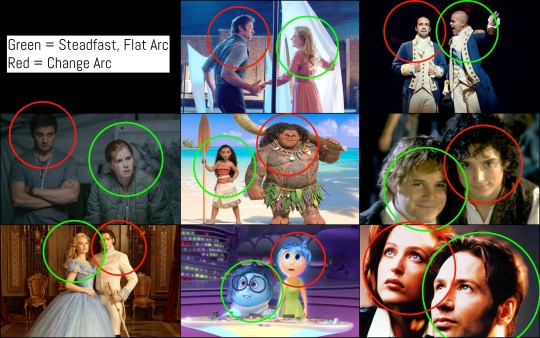
In stories that have a change protagonist, the steadfast character will be the Influence Character. The Influence Character is typically someone the protagonist has an important relationship with, especially through the middle of the story. This is usually a love interest, mentor, or sidekick, but it can be almost anything. Of course, there are variations to the Influence Character, and you can learn more about them in my article on them. The Influence Character also serves as a thematic opponent, to some degree.
Why is the change protagonist most commonly paired with a steadfast character?
Dramatica Theory argues that it's because in order for a story to feel "complete" or "whole"--to properly mimic the human experience--we need to witness each perspective. Otherwise, it feels like something is missing.
It's not impossible to have a change protagonist be paired up with another change character, it's just that when this happens, usually an outsider who is steadfast gets involved and becomes the real Influence Character for both of them. It's also not impossible for the "Influence Character" to be more than one person. A story may have multiple Influence Characters, or even have a group that functions as the Influence Character.
In a story that features a flat-arc protagonist, the types are reversed. The Influence Character becomes a change character:
Moana is steadfast while Maui is change.
In Arrival, Louise Banks is steadfast while Ian is change.
In Cinderella, Ella is steadfast while the prince is change.
In Princess Mononoke, Ashitaka is steadfast while San is change.
In Wonder Woman, Diana is steadfast while Steve is change. (Steve's change isn't as drastic, but if you watch, he moves from disbeleiving the world Diana talks about, to believing in it.)
Usually, this pairing is positive steadfast protagonist and positive change Influence Character. This means that the Influence Character will usually start on the inaccurate worldview--the opposing side of the thematic argument. They will at least voice or tap into it in some way. By the end, they will have an accurate worldview, adopting the steadfast protagonist's perspective.
Generally speaking, anyway, as there are of course exceptions and variations.
So in a sense, when working with a steadfast protagonist, you are reorienting the structure to focus on the steadfast character, instead of the change one.
2. Inaccurate Worldview: Within <--> Without
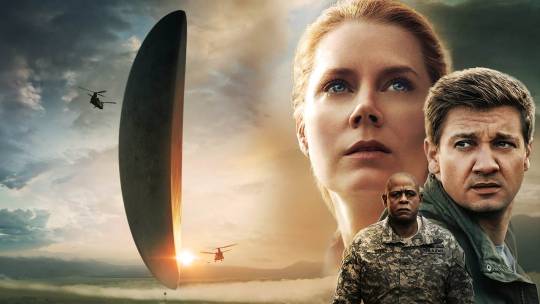
The positive change protagonist has an inaccurate worldview in the beginning--this is sometimes referred to as the "lie" (as K. M. Weiland says it), "misbelief" (as Lisa Cron says it), or "flaw." He will overcome this on his journey and embrace the accurate worldview--the "truth." The truth is also the thematic statement.
The positive steadfast protagonist has the "truth," the accurate worldview, the thematic statement, from the beginning. This means that the inaccurate worldview needs to come from outside them. They need to encounter it in the environment.
You need to have the inaccurate worldview present. Otherwise, there is no opposing argument, no moral conflict.
A theme is essentially an argument about how we live our lives. You can't win an argument if no one is disagreeing. Someone needs to oppose the truth--I like to think of this opposition as the anti-theme. It is essentially the "lie," "misbelief," or "flaw." It is the worldview that is proven wrong by the end of the story.
It's just that with the flat-arc protagonist, that will hit them more from the outside. They will either:
- Enter a society run by the inaccurate worldview
- Have the inaccurate worldview enter their society
- Already live in a society riddled with the inaccurate worldview
Remember, a "society" is simply a collective--it can be as small as a school club or as big as a global government.
I don't know for sure that it always has to be a collective, but even if it's primarily an individual, the inaccurate worldview will still be within the surrounding characters--so in a sense, still part of the environment and society.
In Arrival, Louise is quickly surrounded by people who don't value or understand communication, or how it can avoid confrontation. She does. But she has to put up with that opposition and convince others to share her perspective.
In Princess Mononoke, a demonic boar full of hate and rage enters Ashitaka's peaceful society. After killing it, Ashitaka must journey far away to a land ruled by hate--where he is the only person who stands for peace.
In Wonder Woman, Diana must leave her society behind and enter a world war where humankind doesn't simply fight for a better world, but actively kills the innocent.
Rather than the protagonist transforming within, the positive steadfast protagonist will transform those around them, making the environment a better place as they hold steadfast to the true, accurate, worldview.
3. Internal Journey: Changed vs. Challenged

There is sometimes this idea, this . . . inaccurate worldview 😉 in the writing community that steadfast protagonists can't have rich internal journeys. As someone who loves the internal journey the best out of the plotlines, and who loves many steadfast protagonists the best, I don't find this to be true. Some of the most emotional internal journeys I've experienced, have come from positive steadfast protagonists. And one doesn't have to look far to find examples: The story of Jesus in the New Testament has moved whole nations.
It's fair to say that some steadfast protagonists don't have much of an internal plotline, like classic Superman or 007, but that has more to do with structuring plotlines than it does with character arcs.
For the change protagonist, the internal journey will largely be about transformation--a change. It's a journey to become a better person, and that can be a rich journey indeed.
For the steadfast protagonist, the internal journey will be a test of their beliefs--a challenge. It's a journey about ultimately choosing to hold strong in what you believe in, even if it seems the whole world is against you, (and for a steadfast protagonist journey, that's probably a good idea).
In a strange way, though, these two internal journeys are two sides of the same coin. After all, the change protagonist believes his worldview is the accurate worldview--that's why he has it! He doesn't believe, or at least doesn't clearly see, that he needs to change. The obstacles of the plot will reveal to him he could be wrong, that he needs to fix something about himself. Similarly, the steadfast protagonist believes she's right, and the obstacles of the plot will challenge that by suggesting she could be wrong and needs to bend to the opposing force.
One might argue that the main difference, then, is that the positive change protagonist succeeds at the end by changing, and that the positive steadfast protagonist succeeds at the end by not changing. But I think most of us would agree it'd be more helpful if we differentiated them a little more.
Because the transformation aspect is missing from the steadfast character, it becomes arguably more important to nail the other features of the internal journey. It's not that those features don't exist in the change journey, it's just that without the change itself, they carry more weight and become more centre stage (generally speaking).
One of the aspects that becomes critical, is that the steadfast protagonist needs to pay a high cost. If having an accurate worldview and using it to change the world around them is about as difficult as a stroll in the park, it can become annoying fast. Real life just isn't like that. Even when we are doing good, we still experience hardship, suffering, and opposition. If the steadfast protagonist doesn't have to pay a cost, then they're not really having their beliefs tested.
While a change protagonist's pain may come more from being wrong and having to change--in a sense being "punished" for being wrong--a steadfast protagonist's pain will come from being right and suffering for it, and having to remain true despite that. Essentially they embody the adage, "No good deed goes unpunished."
For example, in Princess Mononoke, in Ashitaka's quest to bring peace to a world at war, Ashitaka must endure a bullet, stabbing, and face death. He's no one's enemy, but he sometimes gets treated as one. He would likely suffer less if he just joined the war efforts and embraced the inaccurate worldview, or if he simply left. Likewise, Jesus holding true to his beliefs in the New Testament, led to him being crucified.
As the obstacles of the plot mount, the steadfast protagonist will be asked to doubt their worldview. Some steadfast protagonists entertain doubt more than others. This may lead to the protagonist wavering in his or her beliefs. Ashitaka entertains doubt only a little, while in Wonder Woman, Diana is brought to her knees by doubt, nearly turning her back on her beliefs. Doubt will usually be strongest at the end of the middle--what some call "The Ordeal," which will lead into the “All is Lost” and "Dark Night of the Soul" moments.
Often, in order for this to work well, the opposing argument needs to appear valid. It needs to look as if the inaccurate worldview could actually be the accurate worldview. It needs to look like the anti-theme could actually be the theme. Like the "lie" could actually be the "truth." This means it becomes perhaps even more important, for you as the writer, to show the legitimate strength of the opposing perspective. If it's obvious the theme is the "truth," then there is no need for the protagonist to experience doubt. There isn't even a need to have a thematic argument. The protagonist may also (or sometimes, instead) doubt his ability or worthiness to live and spread the truth. For more on the power of doubt with flat-arc characters, check out K. M. Weiland's article "Why Doubt is the Key to Flat Character Arcs."
Like costs, stakes become more critical. Stakes are potential consequences. They put pressure on the protagonist and give their choices meaning. If sticking to their worldview means they must suffer steep consequences, their actions carry more weight. It's easy to do what is right when you have nothing to lose. If I found a lost dog, it would be easy for me to look at its tags and return it to its owner. If I found a mean dog trying to bite my hand the evening before my piano recital, wrangled it, saw it belonged to my worst enemy, and still chose to return it--that reveals just how committed I am to saving those lost.
The steadfast protagonist needs to be challenged and tested--one of the best ways to do that is to raise the stakes. Raise them high enough to get them to hesitate, to doubt, to pay a steep cost. In a rich internal journey, we want to push the steadfast protagonist to her limits. What is it going to take to get your protagonist to consider the opposing side? To tempt her to give up her beliefs? In a sense, through the middle, we are really throwing temptations at the protagonist, trying to get her to give in to the opposing argument. Sometimes the most powerful way to do this, is to give the protagonist conflicting wants.
In reality, the audience can't fully see just how steadfast the protagonist is, if she doesn't have to suffer costs, legitimate doubts, and high stakes. It's only in the face of adversity, can we measure true character.
That is the meat of the steadfast protagonist's inner journey.
* I would like to add just one warning, however. In your quest to make your steadfast protagonist struggle, it's important he or she still has some victories along the way. Just as it becomes annoying if the steadfast protagonist never has to struggle, it can also become annoying if the steadfast protagonist never has any success.
4. Ghost/Wound: Inaccurate Belief <--> Accurate Belief
(This is a repeat section from last week. I just thought it would be helpful to have all these elements on the same post.)

A "ghost" is a past, significant, often traumatic event that motivates the character to adopt an inaccurate worldview (the "anti-theme" or the "lie" or the "misbelief"--depending on your preferred terminology). In the industry, this is also sometimes called a "wound." You can learn all about ghosts/wounds in my article, "Giving Your Protagonist a Ghost."
But in a positive steadfast protagonist, this is often flipped. The ghost is often a past, significant, sometimes traumatic event that motivates the character to adopt the accurate worldview (the "theme" or the "truth" if you prefer).
For example, Cinderella's mother, while on her deathbed, tells Cinderella to always be kind. This motivates Cinderella to do just that.
Of course, not every character will have a ghost addressed in the story.
For the positive steadfast protagonist, the ghost may be largely resolved.
But not always. They may not have complete closure and peace. And it's possible they are still traumatized by the event.
Sometimes adhering to what is true can be nearly as haunting as having regrets. It's just that the haunting will come from either the cost of the truth, or, a lack of power--a lack of control--during the ghost. Generally speaking anyway.
In The X-Files, Fox Mulder, in the overall story and theme, is a positive steadfast character. The ongoing theme is an argument of belief vs. disbelief. (The motifs, "I want to believe" and "The truth is out there" speak to that.) However, Mulder has an unresolved, traumatizing ghost: his little sister was abducted by aliens.
This event cements him to the thematic truth of belief and motivates him to investigate anything unnatural. But this happened at the cost of his sister.
Sometimes the trauma comes from not being able to do anything, just as Mulder was powerless to stop the abduction.
Other times it may come from not being able to stop a loved one from choosing the inaccurate worldview--the "lie," "anti-theme," or "misbelief." The steadfast character may be haunted by the outcome of someone else choosing the lie.
5. Want vs. Need <--> I Want the Need
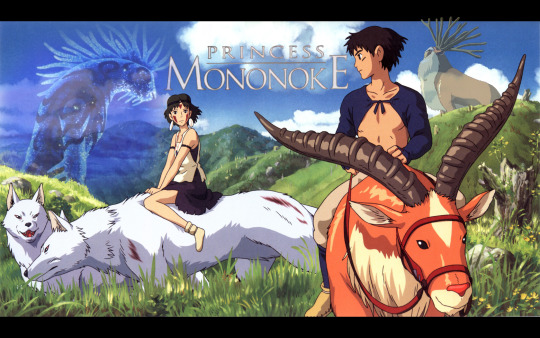
For all other character arcs, what the character wants and what the character needs will be two different things. You can learn about want vs. need in depth here.
In a positive change arc, the protagonist will want something that will manifest in concrete goals, which helps make up the plot of the story. Elsa wants to live in isolation to be herself, so she runs away and creates an ice castle (accidentally freezing the kingdom in the process). The need will be a realization that is thematic--it will be the thematic statement. Elsa needs to learn to be open to love to be authentic--that's what will actually solve her problems.
For the positive steadfast protagonist, the want and the need will be more closely aligned. The protagonist wants what is needed. In a sense, he starts the story with the need. However, the need still has to be applied to the concrete world, which isn't necessarily easy. In a sense, we are taking the need that is within, and trying to apply it to the "real world," which is without. For example, if I know I need to exercise to be healthy, then I probably also want to do that. But that means I still need to put in the work. It also doesn’t mean I know everything about the process--because I may not have full experience with it. I might need to learn a new skill, like how to swim properly.
In Moana, Moana already knows who she is on the inside (thematic statement)--she knows she and her people are meant to sail--but she still has to learn how to sail.
Ashitaka knows the world needs peace, but he doesn't know how to make peace happen within a war. He knows how to have an inner peace, but he doesn't know how to make the external world--the societies around him--peaceful. He's trying to figure it out along the way. He's trying to figure out how to apply a personal experience to the public environment.
The protagonist may still need a greater, more complete understanding of the need, the theme, and how to properly apply it to the real world. We all want to solve world hunger--but how do we actually do that?
On top of that, as the protagonist struggles to meet the need, you may want to tempt him with a conflicting want. In Sam Raimi’s Spider-Man 2, Peter Parker both wants what is needed (to be a self-sacrificing hero) and wants a personal want (to live an ordinary life with Mary Jane Watson). This creates inner turmoil. (And also gives more meat to the internal journey.)
As tests and doubts get heavy, the other want may appear more "right" and enticing. It will almost certainly appear easier.
As tests and doubts get heavy, the flat-arc protagonist may lose sight of the need. In Wonder Woman's "All is Lost" moment, Diana doesn't want to fight for the world she believes in anymore. The world doesn't deserve it. She loses sight of the need, the theme.
In short, the struggle comes from trying to apply the need, being tempting with another want, and/or losing sight of the need.
6. Protagonist Changes <--> Cast Changes

I touched on this earlier, but it's worth giving its own section.
In many positive change protagonist stories, the protagonist will change to the worldview some of the cast members around him have. In Spider-verse, Miles Morales must learn to persevere like the other spider people around him.
In many flat-arc protagonist stories, the cast around the protagonist will change their worldviews to match hers. Moana's journey changes not only Maui's understanding of himself, but Te Fiti's, and everyone's on the island as well.
In some flat-arc stories, this can be critical at the "All is Lost" moment, because if the protagonist is suffering serious doubt, the supporting cast can bolster her by now acting on the accurate worldview, which is essentially what happens in Wonder Woman. As Diana crumbles under doubt, all of her team members enter the fray, prepared to die to make the world a better place. Their selfless sacrifices wake her up, and she recommits to the theme, finding the strength to take on Ares.
Some stories may emphasize these changes more than others, but pretty much always, the Influence Character will at least experience a noticeable change--usually demonstrated near the same place in structure that the change protagonist will change.
But applying the steadfast protagonist to story structure will be for another day (hopefully in the coming weeks). Stay tuned!
#writing tips#writing tips and tricks#writeblr#fanfic#nanowrimo#writing reference#writing advice#protagonist#steadfast protagonist#flat-arc protagonist#moana#arrival#princess mononoke#wonder woman#character#character arcs#writing help
264 notes
·
View notes
Text
They Fought to Make ‘In the Heights’ Both Dreamlike and Authentic

An important change is the decision to make the character of Nina, the elite student played by Leslie Grace, an Afro-Latina woman. She even refers to herself as a trigueña, which implies this was more than just a random casting choice.
HUDES One thing I’ve learned is if you want to make a nontraditional or strong casting choice, you actually have to write it into the dialogue or else it’s so easy for the production to get away from that. So a word like trigueña gets put in there for that reason. I wanted to consciously make Nina Afro-Latina in this version of “In the Heights.” Since we opened the show on Broadway, this national conversation has happened around microaggressions and really interesting stuff that I feel like would be applicable to Nina’s situation.
Was there a number that any of you felt was a deal-breaker and needed to stay?
HUDES At some point, for various artistic or budget reasons, many of the numbers were up for being potentially cut. You really had to make a strong argument for why the film needed them. Because the piragüero [who sells the Puerto Rican-style shaved-ice dessert] is a peripheral character, at one point the “Piragua” song was up for cutting. I tried to talk to Lin gently about this. He was really heartbroken and I was like, “I have one idea for how the studio would let us keep that song.” So I pitched him on playing [him]. That’s how that one stayed.
Lin, why did you feel that the piragüero was so significant to the story?
MIRANDA That song is maybe the fastest song I ever wrote. Although, I don’t know that I wrote it. I think I just caught it. The metaphor of the entire musical is inside that song. Piragüero is every character in this movie. They’re doing their best against impossible odds. They take a breath, then they keep scraping by. It’s a minute-and-45-second song, but somehow the DNA of the entire show is in that minute and 45 seconds. I was very proud that that kernel got to stay. My performance was a testament to my grandfather. He passed away the week after “In the Heights” opened on Broadway. He’s the one member of my family who did not get to see everything that came after that opening night. So I have his espejuelos [reading glasses] around my neck. I have his [Marcial Lafuente] Estefanía cowboy novels in my pocket. I’m wearing my socks up to my tabs and the same kind of shirt he had to wear. I’m really cosplaying as my abuelo.
Quiara, how did you come into the role of producer and why did you decide to take on that responsibility?
HUDES It was a lot of little things that happened organically. When we went to Warner Bros. and Jon came on board, they weren’t saying, “Where are the pages?” They were saying, “What do the pages mean?” I loved having those conversations and saying, “I don’t want to see stiletto heels on any of the salon workers. They’re women on their feet for eight or nine hours a day. Put them in tennis shoes.” Then Jon started asking me, “What would the food look like?” And I was like, “Can we also talk about the pots?” Then I started talking to the choreographer Chris Scott about the dance casting call. I don’t know much about dance, but I did know that at Abuela’s house and out on the street, you’re going to see elderly people dancing and they are going to be schooling the young’uns. At some point I said, “I want to be a producer on this. I’m not just writing words on a page.”
The choice of shooting on location is really compelling, especially when some locations would have been much easier to conceive on a soundstage. Tell me about shooting in Washington Heights and what that adds to the experience.
MIRANDA On paper it’s risky, right? It’s expensive to shoot in New York. It’s hard to shoot on location. It’s harder to shoot in Washington Heights in the summer when we all live outside for a few months a year. But the advantage is you get a million authenticity checks every day because your neighborhood is rolling up with folding chairs to watch this movie you’re going to make about them. Your characters better be dressed like the folks who are on the side, your food better be right. Everything you’re putting in the frame should be an honest reflection of the surrounding everything that’s outside of the frame. I give Jon so much credit for leaning in and listening and finding these corners of the neighborhood that have additional layers of meaning for those of us like Quiara and myself, who still live in the neighborhood.
The concept of the dream, or sueñito, is different for each character. The musical seems to say that you can attain your aspirations without losing who you are to assimilation. That’s a profound notion for immigrants and their children.
MIRANDA It’s that simple and it’s that complicated. You’re talking to first-generation writers whose parents were born on the island of Puerto Rico. You grow up with the “Sliding Doors” thinking: “What if they’d stayed? Who would I be if I grew up in Vega Alta, Puerto Rico?” The nuance that we always fought for is to say, “I can accept the sacrifice of my ancestors. I can accept the responsibility that bestows upon me and still find my own way in the world.” It’s not an either-or, it’s not about, “Forget your dreams. It’s my dreams.” It’s thinking, “I accept the incredible journey you had to take for me to even be standing here and still my job is to make my own way in the world and define home for what it is for me.”
118 notes
·
View notes
Text
The Voyage So Far: Wano (Part Two)
east blue (1 | 2) || alabasta (1 | 2) || skypiea || water 7 || enies lobby || thriller bark || paramount war (1 | 2) || fishman island || punk hazard || dressrosa (1 | 2) || whole cake island || wano (1 | 2)

okay so the wano flashback is possibly my favorite in the whole series for a whole bunch of different reasons, and oden as a character is a big part of why. honestly, i think he’s great. he’s wildly entertaining and ridiculously likable, just like a folk hero should be.

i care about oden and the akazaya nine a lot. they have one of my favorite found family dynamics in the whole series, up there with the strawhats themselves- a bunch of thugs and castoffs who wound up gathering around this one wildly charismatic moron and deciding to be stronger and better for him.
i think they really feel like a family, in these little moments we get of them just interacting and messing around, and it only makes later events- oden’s death, the twenty-year separation, kanjurou’s betrayal- hurt all the worse.
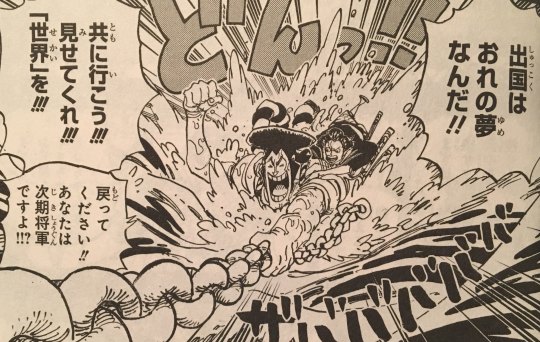
on god it is the funniest thing on earth to me that this is how oden and izou wound up on whitebeard’s ship.
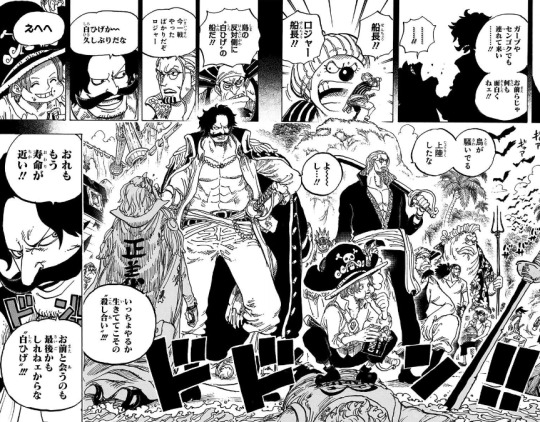
the roger pirates!! i really really like the roger pirates!! i love that there’s this entire predecessor crew who are both absolutely fucking fascinating from a lore perspective and who are just all individually really good characters with really fun relationships. the dynamics we get to see just in this brief part of the flashback are absolutely delightful. i think the fact that i would read a whole series just about the roger pirates is a testament to oda’s character writing.
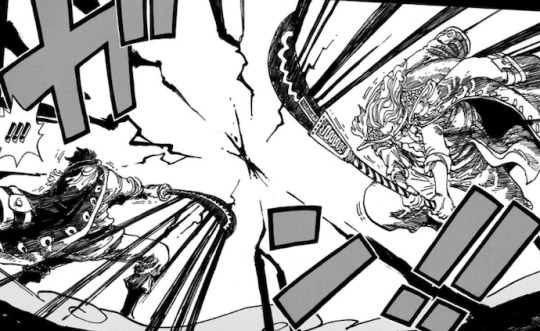
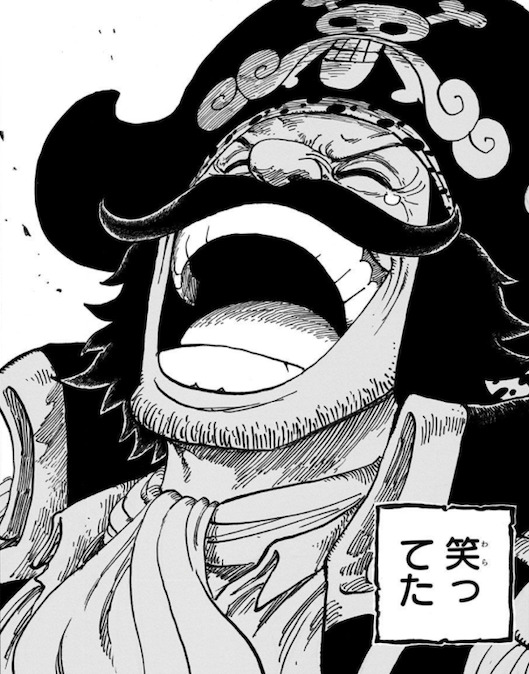
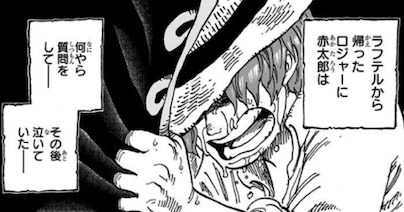
there’s a specific sort of tragedy to the roger pirates, and i think it really hits home in their last few pages in this flashback. by all appearances, they were a crew just as close-knit as the strawhats are. they cared about each other a lot- that ship was their home.
and then their captain died, and they just- fell apart.
awhile back, in my sabaody post, i talked about how we get to know roger first as a story and then as a character by getting to meet characters who knew him personally. to the rest of the world, roger is a story, a name to curse or a height to aspire to. but for shanks and rayleigh and crocus and buggy and all the rest of the roger pirates, he was their captain.
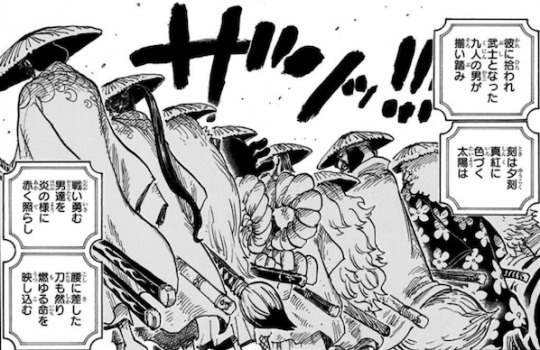
the whole wano flashback, possibly more than any of the others in the series, really feels to me like a story being told, a folk tale being passed down, which makes sense, since it’s canonically framed as oden’s diary entries. and i think that framing device just adds so much to the atmosphere of this entire section of story, the feeling of myth and legend to it.
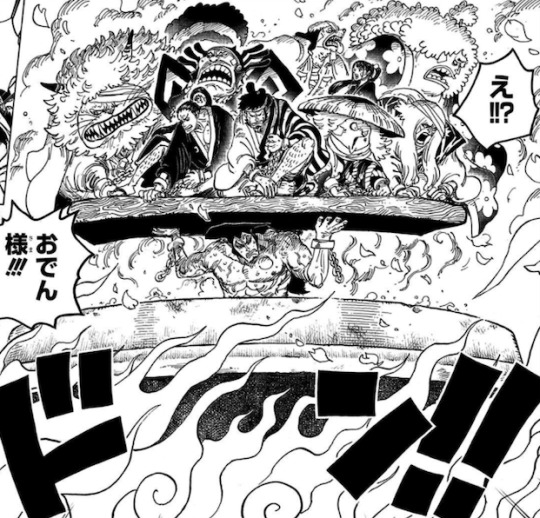
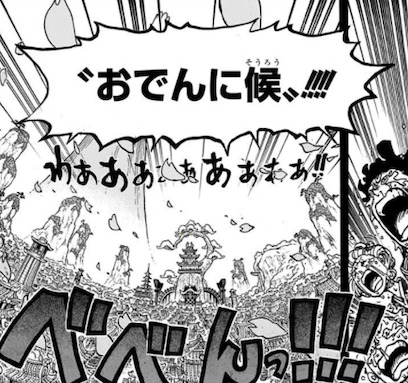
i honestly really like how oden’s death is handled. i have trouble articulating it, but it’s so much, so over the top, so heavily set up and foreshadowed- a legendary death for a legendary man, if that makes sense.
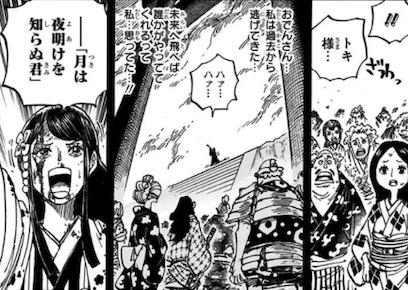
toki’s prophecy is one of my favorite motifs in this whole arc. wano is all about a country that’s been trapped and dying for years and years, holding out desperate hope for salvation. toki is the one who gave them that hope. she doesn’t try to tell them that everything will be okay, she says it will be dark and the darkness will be long, but the dawn will come, and even though she gave her life to do that, she did it smiling.
without toki, the wano arc never would have happened, because there would be no future to fight for.
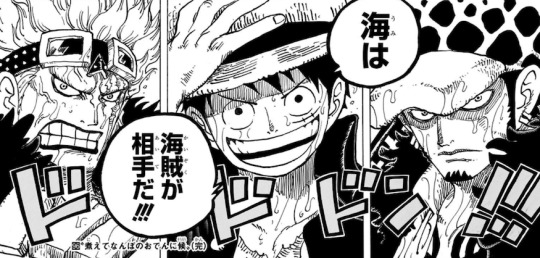
this panel is the header on my favorite op discord server and sometimes i just scroll up and stare at it. it’s so good.
this entire sequence, starting from luffy law and kidd’s entrance, is probably my favorite in wano arc. it’s the turning of the sides, the daybreak after the darkest hour- these three show up, and then jinbe, and denjirou reveals his true colors and it’s revealed all the rest of the samurai left before orochi blew the bridges, and it turns out they haven’t lost a single step to kanjurou’s treachery. it just feels so good to read, after the prior hopelessness of the akazaya and the tragedy of the flashback.

i really like how the akazaya nine are absolutely ready to roast each other at any and all times. that’s how you know they’re best friends.
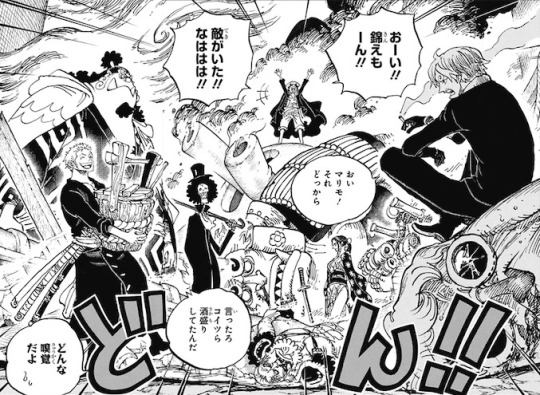
i think i mentioned it back in fishman island, but one of my favorite things is the strawhats just being absolutely cheerfully, chaotically destructive. every time we get to see them wreck havoc while nonchalantly bickering with each other it puts a huge smile on my face.
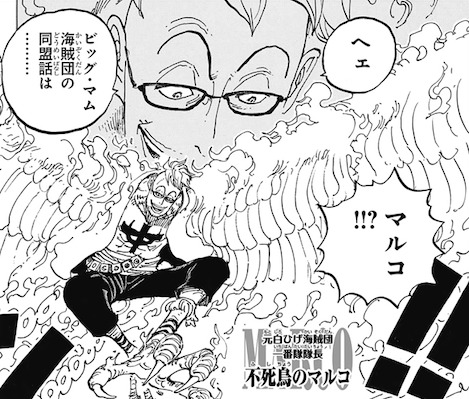

i think ulti and page one are very very funny and i like their dynamic a lot, it’s a laugh riot. i also like that oda lets luffy seriously fight a woman here!! i’m serious, we don’t see enough no-holds-barred fights between men and women (conventionally attractive women, specifically) in this series, so i’m pleasantly surprised when it does happen.

i do appreciate wano’s ability to continuously raise the “holy shit!” quotient without it ever really feeling like a twist just for the sake of the audience. like, i don’t know that anybody saw kaidou killing orochi coming, but at the same time, it feels like it does make sense, given what we know about kaidou, for him to do this.

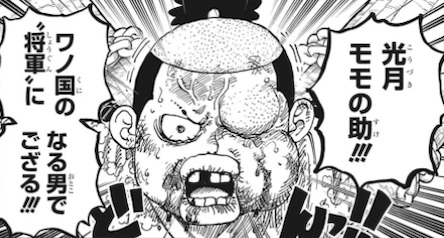
my heart goes out to momo, honestly. he’s only eight, and in that time he’s lost his home and family and his whole world when he was thrown twenty years into the future, and he has the weight of his whole country resting on his shoulders. he’s borne up admirably under that stress, starting from zou and building up to this point.
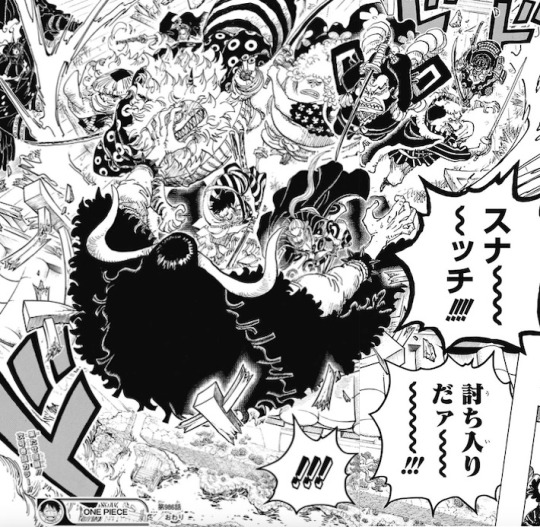
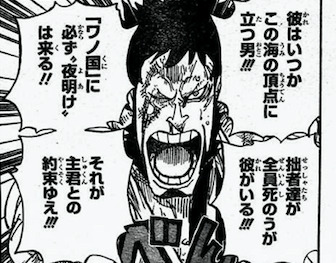
i LOVE kin’emon’s speech to kaidou about luffy SO much. kin’emon’s come a long way from being a mostly comedy relief character in punk hazard to here, where he’s shouting down an emperor. i really like this progression- kin’emon doesn’t change, exactly, but the side of his character that is revealed in wano is very likable and admirable. it goes back to something i’ve mentioned before, about how one piece’s characters are very rarely one-dimensional.
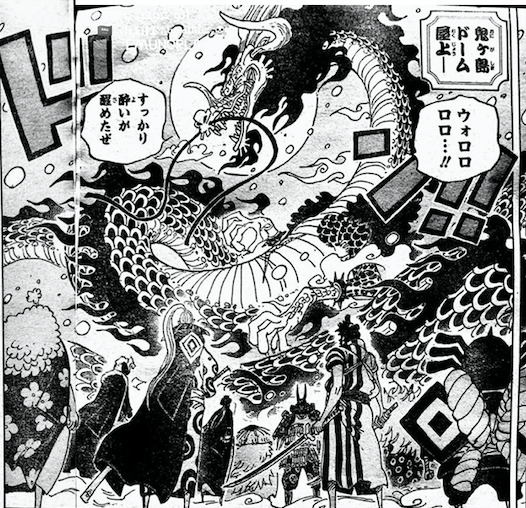
kaidou’s dragon form is extremely cool, and so are most of the panels where it appears- it’s extremely striking, especially in panels like this, where he’s silhouetted against the moon.
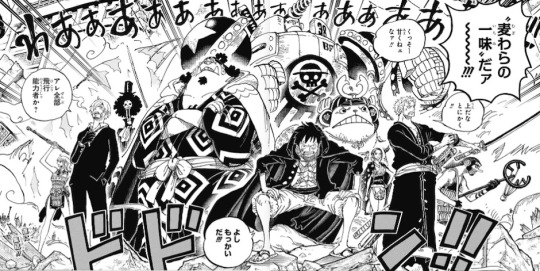
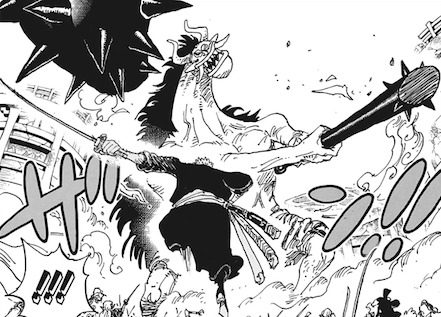

i love... the ripple effects of luffy just being himself that spread throughout the world of one piece, and i think this is one of the best examples. luffy befriended coby all the way back in chapter two, mostly by accident, and now, nine hundred and some chapters later, that’s what leads to drake joining the strawhats’ side. because drake is friends with coby who says luffy is trustworthy, so when drake is stuck with nobody else to turn to, he turns to luffy.
moments like this really reinforce just how much the world and story of one piece is built on relationships between people, and i really like that. i like that instead of necessarily being built around abstract ideals or morals, characters’ actions are, more often than not, motivated by either specific personal goals or by their relationships with other characters. it feels much more true to life.
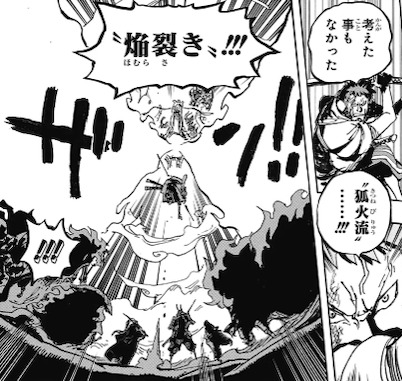
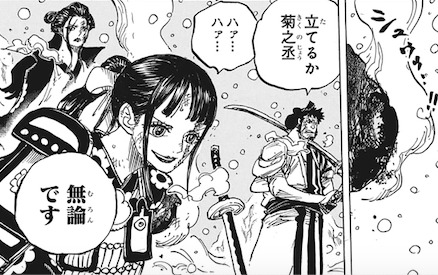
i like the loss of kiku’s arm, because it showcases exactly how serious the fight is on both sides. it both shows that kaidou is fighting to maim and kill and do whatever it takes to win, and that the akazaya are fully prepared to take whatever he throws at them. kiku gets back up smiling after losing her arm. neither side in this fight is even close to backing down, now or ever.
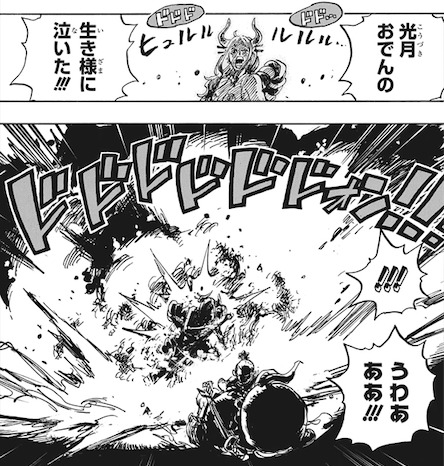
i genuinely can’t believe how long it took me to talk about yamato, so let me just say: i love him so much. part of this, i’m sure, is my personal bias towards any and all kickass queer characters, but part of it is just- he’s so cool. he’s ten feet tall and carries a club about as big as he is and tanks explosions like they’re nothing while also bickering with luffy and falling out of ceilings and generally being like... stupidly lovable.
i just like yamato a lot.
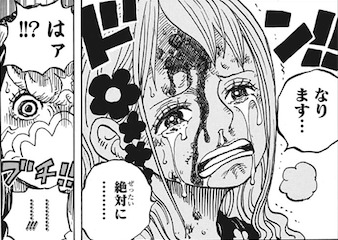
a thousand chapters in, and every strawhat but robin has had a moment where they declare luffy is going to be the king of the pirates, but honestly, i think nami’s might be my favorite yet. nami has always been a person who acts at a distance, not one inclined to direct confrontation and putting herself in danger-
and yet, when it comes down to it, when faced with a choice between death and disavowing her captain’s dream, even when assured by usopp that she would be fully justified in lying for her life, nami chooses luffy. even in the most dire of circumstances, all of the strawhats know luffy is going to be the king of the pirates, and none of them would ever deny it.
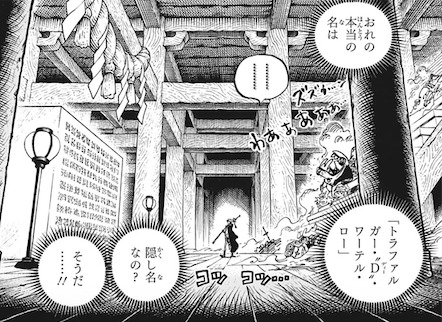
i kind of alluded to this back in my dressrosa post, but i really like the development of law’s new dream being discovering the meaning of the will of d. it just feels like a very good and natural progression for his character, given he’s the only holder of the will of d who we’ve been shown is consciously aware of it and what it might mean. and in general, i like seeing him having something else to work towards after doflamingo’s defeat.
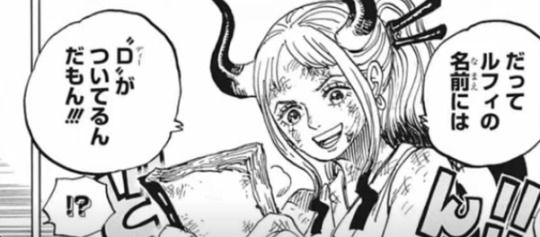
i’ll end this by just saying i am so desperately curious to know what is in that book, and what yamato knows about the will of d, about the dawn of the world, about laugh tale.
guess we’ll find out, huh?
thanks for reading through to the end!! i had a lot of fun putting these posts together, and writing them up was a really cool way to be able to compile my thoughts headed into chapter 1000 and beyond. i can’t wait to see where oda takes us next.
199 notes
·
View notes
Text
Star Wars Visions - Review
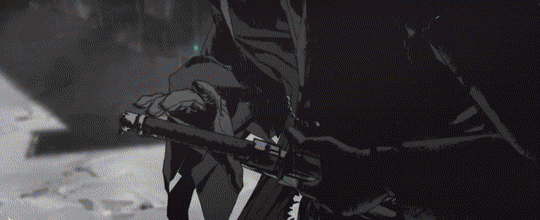
So I finally finished watching all of Visions, the ambitious anime project set in a Star Wars loose if at all canon, and I truly had a good time with it, as a fan of anime and Star Wars I was curious how they would deliver.
Spoilers for Visions, watch it then come back here to read what I thought about it. Reminder: This is my own personal opinion
So as I said, really enjoyed this experiment Disney decided to take, the 9 episodes weren't all flawless but they weren't awful either, so I'm gonna go through what I liked and disliked about it.
We'll start with the negatives, since they're few, picky and it gets it out of the way.
What Wasn't Great
Runtime
A veiled negative has to be many episode's runtimes being too short, some only lasting 10-15 minutes. Before watching I was expecting all to be at least 30 minutes, so it was a shame that none lasted that long.
Episode 2: Glorified Music Video
I think Episode 2 was perhaps the weakest episode of the nine for me, because it was all building up to a song. I think it probably leaned a bit too much on existing characters like Jabba and Boba, as well as Tatooine, to carry interest, so it was a bit of a low point.
Episode 3: Studio Trigger keep their balls away from the wall
Episode 3's The Twins wasn't bad, it just lingered a bit too much on the less fun things. Studio Trigger had made a name for themselves for striking visuals and absolutely batshit crazy fight scenes that ignore all manner of physics with the likes of Promare, Kill La Kill and Darling of the Franxx (and kinda Gurren Lagann, the company was made as a result of that so it's like a Studio Ghibli thing with Nausicaa) but The Twins didn't have enough of the major fight scene for my liking, given how most of what we saw was in the trailer. Maybe it's the fault of the trailer, but it did feel like you could just watch the trailer rather than the episode, which is a bad thing.
Episode 7 too, but it also lacks bravery
The Elder was also a good episode, but it too lacked in the final fight, the ending being very abrupt. The Elder also had a problem in that they wasted their good characters, but also failed in stakes. Had the padawan been killed instead of simply being wounded by a lightsaber slash to the belly it probably would've worked more, since we were shown that the Elder is precise in his cutting and it would've served to increase the urgency of the master fighting him too. The fight was short and out of the characters we lost it was the most important character that bit the dust.
The Episode Order could've been Better
My final criticism has to be that the order of the episodes felt like it could've been better. Starting with The Duel was right but following it up with Tatooine Rhapsody brought the mood down, likewise putting The Elder after T0-B1 was perhaps too jarring a theme switch. The bigger sin was probably ending with Akakiri. Akakiri was good, but it was a downer and you don't really finish a Season 1 on a downer because you want people to feel excited for more rather than feeling bleak about it; with the options of Lop & Ocho, The Elder, The Village Bride and The Ninth Jedi (which would've been my pick for episode 9) it was an odd choice to pace the episodes in such a way - even when knowing that people would binge in this order.
FYI if you wanted to know how I would've ordered the episodes it would've been
The Duel -> The Elder -> The Twins -> Lop & Ocho -> Tatooine Rhapsody -> T0-B1 -> The Village Bride -> Akakiri -> The Ninth Jedi
This way we start strong with Sith-heavy episodes that grip with combat, we have the Duel to set us off, we show off the Elder to sell the Dark Side's strength, which blends into the Twins and that sibling relationship blends into Lop & Ocho, we use Tatooine Rhapsody as an intermission of sorts but then carry the lighter theme with T0-B1, whose artistic elements and worldbuilding leans into the Village Bride. We make Akakiri the penultimate since we show the Jedi succumb to the Dark for love in contrast to the Elder where the Jedi succeeds by steeling emotions, before finishing strong with Ninth Jedi.
What Was Great
Anime is perfect for Star Wars
Star Wars has of course delved into animation before; Clone Wars (both), Rebels, Resistance and Bad Batch, but never like Anime. So Visions was allowed to shine by showing off everything anime can offer which more realistic CGI and live action could not. Bright colour grading, physics-defying movement, as well as unique character and lightsaber shapes.
(Mostly) Not Wasting Time
While I have criticized some episodes for not making the most of things, and not having enough time, but many episodes would last 12-15 minutes and still feel like they had a coherent storylines with no gaps in getting to know the brand new characters or a lack of important information and investment. It is a testament to the good writing of the episodes that episodes got so much from such little time.
We're Left Wanting More
In spite many episodes' brevity, the good writing also provided us stories with great potential to be fleshed out. Who wouldn't want to learn more about these new characters? See most of their adventures? The franchise potential from certain stories' one episode makes the experiment an unequivocal success.
The different styles add to the story
Using a different anime studio for each story allowed each episode to stand out in their own way, and lean on different areas of importance. The Duel for instance applied a Kurosawa aesthetic which made the audience anticipate samurai themes. As much as the animation will get props for its visuals, environments and character design we should also give a hat-tip to the amazing music, especially in The Village Bride, and the voice acting from both JP and EN.
We had some recognizable faces on both sides with EN having Joseph Gordon-Levitt, David Harbour, George Takei, Neil Patrick Harris, Allison Brie, Simu Liu, Karen Fukuhara, Lucy Liu and Taemura Morrison reprising as Boba, while on the JP side we had names familiar with One Piece (Zoro - why you gotta be a sith Zoro!, Brook, Tama, Kiku), DBZ (Goku), Naruto (Hidan, Tayuya and if you count Boruto; Chocho and Kawaki), Jujitsu Kaisen (Itadori, Megumi, Nobara) and more.
The different styles also allowed a greater freedom to lore between studios, I know the lightsaber colour thing was done in High Republic but I did like how in the Ninth Jedi Kara's lightsaber started out translucent (I actually preferred it that way), while not diverting too far away from the canon.
The Samurai style episodes were the strongest
While some episodes leaned on other elements of Star Wars, the best of the bunch kept true with the correlation force users had with samurai. The Duel, Village Bride and Ninth Jedi - alongside Akakiri, Elder and kinda T0-B1 - had strong showings by maintaining their force user characters as samurai or samura-esque, which only added to the themes of the episodes too.
Its success will hopefully entice more Studios and Directors
A positive for the future is the fact that there is a future. Visions has plenty of mileage as both a series of one-off stories or stories that can be expanded upon, and its success will mean that more will be on the cards. Imagine now what other studios may want to try their hand at their own story in this universe? And what it does not only for the franchise but also the animation studios themselves, because this in itself becomes a bridge for fans on either side to be introduced to the other; new anime fans, new star wars fans, everybody wins.
Conclusion
Visions provides an alternative in Star Wars media outside of live action but also away from the CGI tv shows, but it has started off strongly almost as well as The Mandalorian and in my opinion better than the Bad Batch did. My favourite episode was probably the Ninth Jedi, but Village Bride and the Duel are close runners up, soon followed by Lop & Ocho, I hope very much that the stories these ones started especially can be fleshed out and maybe even greenlit for their own series, while also curious about what more Star Wars can deliver.
All in all, good job for everyone, they took a risk and it paid off.
#star wars#star wars visions#sw visions#sw visions spoilers#the duel#tatooine rhapsody#the twins#the village bride#t0 b1#lop and ocho#akakiri#the elder#the ninth jedi
20 notes
·
View notes
Text
The 8 Theory-Folklore’s Commentary on Youth
Yesterday, I took note of @taylorswift and her careful attention to the number 8.
“Not a lot going on at the moment” had 8 words. The 8th track is “august,” which is also the 8th month in the year. She has 8 deluxe editions of her album. Many attributed this to Folklore being Taylor’s 8th album. I thought it meant either a.) we needed to pay very close attention to track #8 or b.) that 8 references infinity, a.k.a “forever and ever.”
To my surprise, I was actually selling Taylor Swift short.
When listening to the album, there’s a lot of back and forth in emotion and circumstance. I was confused about the order, especially when the strikingly sobering “hoax” followed the self-aware almost-tranquility of “peace.” Then it hit me. There are two schools of thought going on.
There are 16 tracks on Folklore (excluding the bonus track none of us have heard). 16/2=8. This means there are 2 equal emotional song threads on the album. In other words, you can get two drastically different lessons listening to each group of 8.
When you separate the even numbered tracks from the odd numbered tracks you get the following:
Odd
the 1
the last great american dynasty
my tears ricochet
seven
this is me trying
invisible string
epiphany
peace
Even
cardigan
exile
mirrorball
august
illicit affairs
mad woman
betty
hoax
Odd Interpretation:
Starting with “the 1” and “the last great american dynasty,” the lyrics are very upfront in showing that the protagonists are making fully intentioned mistakes. “the 1” says, “in my defense, I have none for never leaving well enough alone” (I see you “ME!” reference). In “the last great American dynasty” it says, “she had a marvelous time ruining everything.” These characters’ folly is their youth-induced selfishness. They’re casual in the harm they cause because they distance themselves from it. They’re fine with what they don’t look at closely. When you’re young, you make a mess of things in service of YOUR need. Your need for companionship. Your need for the thrill of danger. Your need to make your mark, to be somebody, to leave something behind. The marvel of the excitement and the chase and the very vitality of teens to 20-somethings’ shenanigans blinds us to the scale of our destruction…
…until you have no choice but to face the consequences of your recklessness.
The next track, “my tears ricochet” is not your average track 5. It functions as a pivoting point. Now our narrator is the hurt party, the one baring the brunt of callous treatment. Fickle mistreatment is no longer so casual. Now it’s a torment, and the tormentor learns the scale of their damage. So much so, that they get burned too. They learned their lesson at a terrible price, but what’s most important is that they learned.
“seven” is a long-overlooked memory revisited. In this picture of naïve innocence, the narrator tells of their childish belief in the impossible. Through magic and play pretend and fantasy they are invincible. They have all the control in the world to control the world they live in. Obviously, this is a flawed perspective that everyone eventually grows out of. Fairy tales don’t solve real problems. The point is that their sense of self-importance is in service of a stronger moral compass than the first two songs. If we accept our responsibility to others, to do what we can to ensure their welfare, are we not better and more satisfied people for it?
“this is me trying” hears that lesson and attempts to walk the walk. Part of being responsible to your fellow human is taking accountability when you fumble. The narrator doesn’t know what to say or how to make it right. What they do know is that they’re here, they’ve put the bottle down, and that they’re willing to try what’s necessary to heal what they’ve hurt.
“invisible string” gives us the reward we’ve been waiting for. The narrator says, “cold was the steel of my axe to grind for the boys who broke my heart, now I send their babies presents.” This is someone who has gone from lashing out in anger at a partner from a burned relationship to genuinely wishing them well in their next stage in life. It’s a powerful testament when you can recognize that youth drives us all to make hurtful decisions and that no one is immune to change if they truly want to change. When you let the anger and lies go, the strings that tied you to them fade away. All that’s left is the string you want to hold onto. The string tied to the one who matters, because you’ve made the conscious decision to deduce that their worth as a person should equal yours. It’s a painful path to traverse through, but when you do it’s all worthwhile. That’s why the narrator can say with confidence “hell was the journey but it brought me to heaven.”
In any other album, a song like “invisible string” would be the quintessential emotional payoff for this story arc. However, because this album is a masterpiece, we have a different payoff point in “epiphany.” “epiphany” takes us out of the world of a romantic relationship. We hear descriptions of war and nurses dealing with the despair of this international pandemic. This point in this emotional thread is that it powerfully declares it’s not enough to do no harm nor is it enough to just empathize with your romantic partner. You MUST show your responsibility to your fellow man. Stand beside them. Empathize with them. See them as whole human beings. Do good by them. In other words, it is our duty to do right by everyone, for everyone bleeds, loves, and dies.
The 8-song selection ends with “peace.” The song begins by saying that their, “coming-of-age” has come and gone.” I believe this (along with “invisible string”) to be the most overtly “Taylor Swift” track in perspective. This is her speaking as herself. She lets us know that she’s grown through taking her mistakes, and the mistakes she learned through folklore, into account. She is overly aware of her flaws and feels she pales in comparison to her partner. Rather than allow those insecurities to manifest in unchecked rage or resentment, she takes it as a challenge for herself to do better. She knows she can never give him complete peace (due to inside and outside factors), but she can make the choice to give him unselfish promises and embrace the entirety of her partner’s life. This is a person who has learned the value of selflessness in love and life, which makes this whole thread worth everything.
Even Interpretation:
“cardigan” foreshadows the eventual failure of the even path. The odd interpretation I just described culminated in the narrator finding their place with “the one” because they’ve left everything petty and casually cruel behind. In “cardigan” it says “chase two girls, lose the one.” On top of this directly referencing the first track, it also implies the partner’s self-destruction. By toying with two girls, James is losing “the one.” I don’t think losing “the one” means that you keep one of the two of them. I think it means that engaging in that kind of behavior makes you into a person that isn’t ready, or worthy, of “the one” that they are meant to be with forever. Meeting and keeping “the one” has to require each partner to love themselves and their partner wholly, truly, and selflessly. They can’t be a cardigan you pick up and only wear on the weekends. They must be a wholehearted commitment.
“exile” shows the blowout from “cardigan.” The two couldn’t stay together, and Bon Iver’s (character’s) toxicity comes out full force. He thinks her new man is lesser than him. He’s prepared to throw punches despite being at fault over a hundred times. He’s seen the film before, and he didn’t like the ending because it didn’t work out for him. He wants her under his thumb, not having learned from his prior relationships that that just can’t work. They leave out the side doors, neither fully ready to confront the problems head on.
“mirrorball” is daring in its shift of focus. While all of the tracks I’ve mentioned thus far have dealt, in some way, with the problems that result from a young person’s selfishness, this song doesn’t do that. This song illustrates an extreme that young people participate in at the opposite end of the spectrum; radical selflessness. To be selfless means that you should never allow something that harms someone else to happen just because it benefits you. Young people, girls in particular, are often groomed to interpret selflessness differently. Their definition is synonymous with accommodation. Change your looks, change your personality, don’t object, and embody what your partner wants so that they’re happy. That’s why the symbol is the mirrorball in the song. It reflects everything in the room but itself. By explicitly not factoring in their own sense of self-respect in a relationship, they are unknowingly and tragically enabling their partner’s mistreatment. To be clear, that doesn’t mean abuse is their fault if they have low self-esteem. It’s not, even remotely. But not having the capacity to defend your self-worth is what keeps so many drawn into toxic relationships there for so long. This radical selflessness manifests itself in the other woman too. In “august” it explicitly says that she was living on the, “hope of it all” and that she would cancel plans in the name of a potential hookup with someone who was never hers. The idea of radical selflessness culminates in “illicit affairs” when one of the women deals with their addictive compulsion toward someone who treats them like a cheap lay. Their relationship is a secret that leaves her feeling used in parking lots and as though any trace of her is gone. These three songs have taken the desperate hopelessness of “Abigail gave everything she had to a boy who changed his mind” to the extreme.
Many have speculated that “mad woman” is a commentary on the Taylor/Scooter conflict and I’m inclined to agree. However, if I were to assign an interpretation that goes with my theory, I would say that “mad woman” details the unforeseen consequences of a tormentor’s abuse. When a toxic partner performs bad behavior, their expectation is that they will always be found in the right. After all, Taylor noted on her previous album that for men, “everyone believes [them].” So in the face of lies about her character that everyone believes, she gets rightfully angry. Her anger is their affirmation. For many, a woman being angry on her own behalf is “crazy” and “irrational.” What kind of a society have we set up? A society that promotes women to lack self-worth and, should they find it, they’ll meet a whole other exile.
“betty” is our complete look into James’ perspective. On its own, it sounds like a big romantic gesture to get behind. However, this path is very clear to put “cardigan” first. “cardigan” says, “I knew you’d miss me once the thrill expired and you’d be standin’ in my front porch light.” Lo and behold, in “betty” he shows up to her party when she doesn’t want to see him and asks if she would, “kiss [him] on the porch in front of all [her] stupid friends.” It’s an absolute punch in the gut. Betty knows in “cardigan” that he would come back after he had his fun with another girl, but that she would take him back when he saw momentary value in her again. James in “betty” claims he didn’t know anything, but that’s just an excuse. He knew what he was doing, he knew that he would be able to pick up her broken pieces with ease, he knew he could isolate her from her friends, and he knew that he could capture the imperfect “comfort” of that cardigan again.
This path ends in the final even-numbered song, “hoax.” In the odd numbers, “peace” shows a lesson learned. This even path shows what happens when we don’t learn. The seeds of youth-driven mistakes have led us here. The narrator wants nothing outside the pain of this faithless love. Without learning what it means to be selfless, the traumas of these young relationships create a never-ending cycle. The narrator knows that the “love” is a “hoax” but doesn’t care because that’s all they have. There’s no point to wanting anything else. Without the perspective of age, of truly going beyond that, they’re stuck in a truly dark place.
Final Thoughts:
Taylor Swift is an exceptional artist for a lot of reasons. No one makes albums this good this far into their career. Most artists teeter off after two or three because they retread. Their audience inevitably gets bored of them e same thing time and again. Repeating themselves is something that a lot of artists do because they want to go with the formula of what works. With Folklore, Taylor has done what few artists have dared to do. She’s allowed her discography as a place to uncompromisingly expand her worldview and challenge her listeners. She’s not reiterating previous lessons to make another quick sale. Instead, every album prior has been a steppingstone. As she said at the Time 100 Gala, she has truly turned her lessons into her legacy. From a variety of narrators, she has brought what I decree to be her best album to date. This wouldn’t happen for anyone else 8 albums into their career, but she’s done it by devoutly embracing age’s wisdom.
Learn from the highs and lows presented in these paths. As all good folklore does, it teaches us how to live better. It is our duty to live selflessly and with self-assured dignity. These writings, I have no doubt, will become integral to the legend that is Taylor Alison Swift.
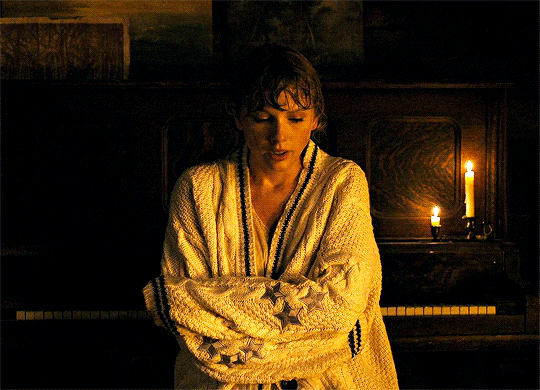
#folklore#taylor swift#ts8 theories#ts8#the 1#CARDIGAN#the last great american dynasty#exile#MY TEARS RICOCHET#mirrorball#seven#august#this is me trying#illicit affairs#invisible string#mad woman#epiphany#betty#peace#hoax
585 notes
·
View notes
Text
Aaron Dessner on the 'Weird Avalanche' That Resulted in Taylor Swift's “Evermore”
By: Lyndsey Havens for Billboard
Date: December 18th 2020
One day this fall, Taylor Swift walked into Aaron Dessner’s home to wish his daughter a happy 9th birthday - but that wasn't the only reason Swift was there.
She was mostly there to film the Disney+ special, Folklore: The Long Pond Studio Sessions, in which she was meeting up with her primary Folklore collaborators - The National’s Dessner and Jack Antonoff. They had all gathered for the first time at Dessner’s upstate New York studio to play her record-breaking album live.
On the last night of filming the special (a process that was done while following CDC guidelines, with a limited crew and COVID-19 testing), Dessner recalls how he, Antonoff and Swift stayed up until 4:00 or 5:00 a.m. - drinking and celebrating the more-than-warm embrace Folklore had received. But in the days that followed, Swift ended up staying, and she and Dessner unexpectedly continued working. Eventually, they had 17 more songs, all of which became the sister album, Evermore, released on Dec. 11.
“Folklore almost immediately was treated as a classic or a masterpiece,” says Dessner. “It was elevated fairly quickly and had been commercially really successful, so obviously it’s hard to follow something like that up. But one of the things I love about Evermore is the ways in which Taylor was jumping off different cliffs. The ability she has to tell these stories, but also push what she’s doing musically, is really kind of astonishing. It’s like I went to some crash course, some masters program, for six months.”
Below, Dessner tells Billboard all about the work that went into his second album in five months with one of the world's biggest pop stars.
With Folklore a lot of the production and arrangements came from a folder you had sent Taylor. Did you continue to pull from there, or was Evermore made from scratch?
A lot more of it was made from scratch. After Folklore came out, I think Taylor had written two songs early on that we both thought were for Big Red Machine, “Closure” and “Dorothea.” But the more I listened to them, not that they couldn’t be Big Red Machine songs, but they felt like interesting, exciting Taylor songs. “Closure” is very experimental and in this weird time signature, but still lyrically felt like some evolution of Folklore, and “Dorothea” definitely felt like it was reflecting on some character.
And I, sort of in celebration of Folklore, had written a piece of music that I titled “Westerly,” that’s where she has the house that she wrote “Last Great American Dynasty” about. I’ll do that sometimes, just make things for friends or write music just to write it, but I didn’t at all think it would become a song. And she, like an hour later, sent back “Willow” written to that song, and that sort of set [things in motion] and we just started filling this Dropbox again. It was kind of like, “What’s happening?”
And then it just kept going. She wrote "Gold Rush” with Jack [Antonoff] and by the end there were 17 songs, and it was only a couple months after Folklore came out, so it’s pretty wild. Each time we would just be in disbelief and kind of like, “How is this possible?” Especially because we didn’t need to talk much about structure or ideas or anything - it was just this weird avalanche.
Considering how industry-shaking Folklore was, what pressure did that introduce this time around?
I think because of how we made it, it really wasn’t like producing some giant record or something, it still had this very homespun feeling to it. There may have been a moment or two when I think Taylor was wondering when and how to put out Evermore, but I think the stronger it became, and as each song came together, it just started to feel like, "This is a sister record - it’s part of the same current of creativity and collaboration and the stories feel inter-related."
And aesthetically, to me, Evermore is wilder and has more of a band dynamic at times. You can feel her songwriting sharpen even more on it, in terms of storytelling, and also just this freedom to make the kinds of songs that were coming. When she started to write in a less diaristic way and tell these stories, I think she found she had this incredible wealth of experience and depth to her storytelling that was quite natural. She could easily make these songs more reflective or blur the lines of what’s autobiographical and what's not in interesting ways. It felt like the most natural thing in the world.
Folklore was made entirely remotely, how did that process change for Evermore?
This was both. Some of it was remote, but then after the Folklore: The Long Pond Studio Sessions, Taylor stayed for quite a while and we recorded a lot. She actually wrote “‘Tis the Damn Season” when she arrived for the first day of rehearsal. We played all night and drank a lot of wine after the fireside chat - and we were all pretty drunk, to be honest - and then I thought she went to bed. But the next morning, at 9:00 a.m. or something, she showed up and was like, “I have to sing you this song,” and she had written it in the middle of the night. That was definitely another moment [where] my brain exploded, because she sang it to me in my kitchen, and it was just surreal.
That music is actually older - it’s something I wrote many years ago, and hid away because I loved it so much. It meant something to me, and it felt like the perfect song finally found it. There was a feeling in it, and she identified that feeling: That feeling of... “The ache in you, put there by the ache in me.” I think everyone can relate to that. It’s one of my favorites.
Did you watch the Disney+ special?
I’m not a big fan of watching myself - but I did watch it, and I thought it was beautiful. It’s funny, because it was very DIY in a sense; a tight little small crew was there to do it, nobody was styling us or fixing our hair or anything like that, it’s very authentic. I rehearsed a little bit before, but both of us - Jack and I - were pretty much figuring it out as we went.
And I think the nice thing is that all of the songs could work like that, and that’s partly a testament to the strength of the album. Without big production tricks or backing vocals or anything like that, the songs stand up, and Taylor just sang the crap out of them. And hanging out with them was so much fun. They’re kind of like siblings almost; they’ve known each other a long time, there’s this quick humor between them.
Would you like to do something like that again with Evermore?
I don’t know if you can recreate exactly what we did with Folklore. I haven’t actually talked to anyone about that. But to me, the songs of Evermore would be even more fun to play, because more of them feel like band songs. But, that being said, I won’t be disappointed if we don’t - there is no plan afoot right now to do that.
During an interview on Jimmy Kimmel Live! Jimmy asked Taylor about the rumors behind Woodvale and if there’s a third album coming, to which she said she’s exhausted. How are you feeling energy wise?
I think we both feel like it was Mission: Impossible - and we pulled it off. I imagine that we’ll make music together in some ways forever, because it was that sort of chemistry, and I’m so thankful and grateful for what happened, but I think there’s a lot there. It’s not just the two albums, there’s also bonus tracks, and two of my favorite songs aren’t even on this record. We’re not pouring into another one now.
I’m going to finish the Big Red Machine album - I was really very close to finishing it when all of a sudden the Folklore and Evermore vortex opened up, and actually Taylor has been really helpful and involved with that as well - and The National is starting to talk about making music, and I think she’ll probably take a break. But I’m so excited for any future things we might do -- it’s definitely a lifelong relationship. And I’d say the same for all the people who worked on these records, including my brother and everybody who contributed. It’s a really special legacy.
#lmao#I love that she just sends him on a press tour while she chills somewhere#honestly - I'd do that too if I was her#=)#billboard#interview#Aaron Dessner#taylor swift#folklore album#evermore album#evermore era#folklore era#songwriting
143 notes
·
View notes
Text
X-Men Abridged: 1978
The X-Men, those take-me-to-the-ballgame mutants that have sworn to protect a world that hates and fears them, are a cultural juggernaut with a long, tangled history. Want to unravel this tapestry? Then read the Abridged X-Men!
(X-Men 109 - 116) - by Chris Claremont and John Byrne, Tony Dezuniga

Yes, the plan here is to toss Kurt at Magneto and yes, it’s objectively the best panel of 1978. (X-Men 113)
If the X-Men were a tv-show, the Phoenix mending the M’Kraan Crystal would probably have been the finale of season 1 of X-Men: the New Generation. Now that we’ve had this big finish, Claremont takes his time to sow new plot seeds and navigate his team of merry mutants in new directions. Compared to 1977, 1978 is a lot more laid back, with smaller arcs and more character moments.
Take the first two issues of the year, for example. The victorious X-Men come home from their space capers and for a moment, all is well. Ororo is a plant mommy, Kurt is a grade-A cutey and Jean comes out to her parents as the Phoenix. (Intrigued? Read more here.) And, because Moira going back home to Scotland, the X-Men say goodbye to her through… a baseball game! (Which, I guess if you’re comic book character bound by the comic book code, is the next best thing to just getting drunk together.)
It’s all very straight-edge wholesome.
Lilandra is very absent: I’m assuming she is sleeping off the space jetlag somewhere. idk
Sure, there’s still a few action-packed B-plots: a fight scene is mandatory in a comic book, after all. Weapon Alpha tries to claim Wolverine in the name of the Canadian government and some nobody named Warhawk sneaks into the mansion as a phone repairman to rig the Danger Room into a Death Trap.
(Look, you have a danger room. Why are you calling phone repairmen? During breakfast, did Charles go around the table, asking anyone if they wanted to fix the phone and everyone was like “nnnnnno, I am le tired”.)
Anyway, how would you unwind after a baseball game? Scott has an awesome idea! (I'm betting Scott would have embraced the Comics Code.)

This is the one issue not drawn by John Byrne this year. Dezuniga does a fine enough job, but Jean using her powers looks like she’s barfing psy-energy all over the place. (X-Men 110)
Warhawk traps the rest of the X-Men in the Danger Room. Wolverine gets a moment to shine as the team’s rogue, finally getting a win after getting knocked on his ass lately. Also, Kurt calls Warhawk Krieghabicht. (Hee.) Jean, meanwhile, is startled because despite her phenomenal powers, she was taken out so easily. She makes the formal choice to rejoin the X-Men.
And the next time we see them… THE X-MEN HAVE VANISHED? (yes, i know this sentence contradicts itself, shut up)
We find Beast at a circus in Texas, investigating their disappearance while on a sabbatical from the Avengers. See, Lorna called him because Havok was kidnapped in Scotland and the X-Men did not pick up, so she called good ole Hank McCoy. We know Charles is honeymooning with Lilandra, so where are the X-Men?
Cerebro leads Hank to a circus and, dude, for someone who’s supposed to be a genius, you draw the conclusion that these are the brainwashed X-Men way too slowly.
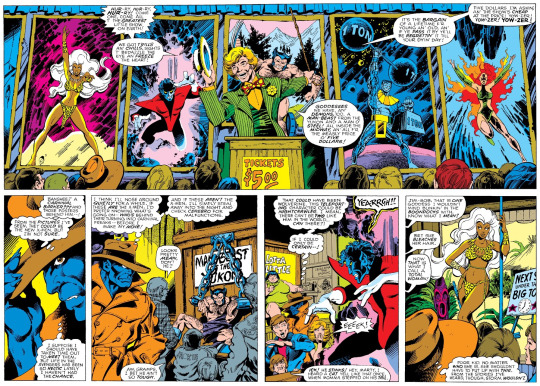
I by no means wish to belittle Storm’s situation, but Wolverine is in equally skimpy clothing while chained the fuck up, Beast. Can’t spare a little sympathy for him? (X-Men 111)
Beast continues being the worst detective mutantkind has ever known: even Jean, who’s currently a cigarette smoking trapeze artist named Miz Destiny, barely convinces him that these are the X-Men. When Beast finally confronts the Ring Leader, it turns out to be… Mesmero!

This pose: appropriate for a super villain or suitable for a Harlequin novel cover? Especially with all this talk about enthralling? (X-Men 112)
Apparently Mesmero doesn’t give a fuck that half these X-Men aren’t the same X-Men that fought him before. Revenge is a dish best served cold and to the wrong table, apparently. Beast fighting ole Messy causes Wolverine to spring free from his hypnotic influence. Wolvie proceeds to slap Jean out of it (literally) and they free the rest of the X-Men. But when they come and confront Mesmero in his little circus wagon, their villain is knocked out…
By Magneto.
dun dun DUN
Magneto proceeds to kidnap them, like this:

Magneto, who has no patience for narrative baggage, also yeets out Mesmero over the Andes, no big deal (X-Men 112)
Just like Mesmero, Magneto wants misplaced revenge. Instead of exacting vengeance on Charles, Moira and the Defenders involved in (literally) infantilizing him - no, seriously, he was a baby - Magneto comes for these All-New X-Men. (Look, logic has never been one of Magneto’s super powers.)
He takes the X-Men to his secret base below the South Pole, tucked away under a literal volcano. (He really should be on the tourist board for Amazing Antarctica, this is his third base there.) The X-Men, after they have safely landed, attack him, but they are tossed around like rag dolls, falling one by one - even the Phoenix.

Jean does have the right idea, though: it’s my theory that the key to defeating Magneto is being equally dramatic and hammy. (X-Men 112)
Somewhere on a cruise ship, Charles loses contact with the X-Men and proceeds to do absolutely nothing about it. Damn, but Elizabeth Taylor Lilandra must have some pretty choice moves in bed.

YOU COULD TRY FINDING OUT, CHARLES. (X-Men 113)
When the X-Men wake up, they're bound by Nanny, a robotic… uh, nanny! And Magneto unveils his revenge: he has scrambled the X-Men’s brains: they are fully conscious, but are trapped, powerlessly in their bodies, which won’t follow the instructions of their brains. It’s as if they’re the minds of adults, trapped in the bodies of infants - just like Magneto was. (He does not succumb to an evil laughter, but he’s definitely drifting into Evil Overlord territory.)
Look, a lot of this is very silly. Magneto hasn’t really been codified by Claremont yet: he’s still very much the sixties super villain and he doesn’t have his Holocaust-past yet. His motivations don’t make much sense: it’s never made clear why he needs the base, for example, or why he doesn’t just kill the X-Men. And yet, he seems more menacing than he used to be. Might be because these X-Men actually have a hard time beating him.
A lot of this era works like that. There’s the occasionally very silly trappings of a superhero comic, but there’s also glimmers of exceptional writing. Take the following scene, for example, which I’ll just include in its entirety, because fuck it. Storm is trying to break free, on the flimsy premise that she was a highly advanced baby who had the motor skills of a toddler. (I’ve met babies. They basically eat, sleep and poop. They can’t really do this.) And yet? This scene kind of works.

Like, the fact that this scene works despite the fact that Magneto thought to give his Nanny-robot a sixties copper bob-cut and a aluminium French maid headpiece is a testament to effective writing. (Also to Magneto’s attention to detail.) (X-Men 113)
No worries, Storm succeeds the second time she attempts this.
Together, the now free team manages to almost defeat Magneto, but Phoenix grows a little too zealous, destroying precious machinery. It proves to be their undoing: the roof to the base cracks open, letting lava in. Things grow dire and Magneto gets the nope out of there.
The lava turns on the heat and the team gets split up. Phoenix escapes together with Beast, and they both collapse into the freezing snow in the Arctic. A helicopter saves them, but what about the rest of the team? Are they dead?!
They’re dead enough for Professor X, and I really have questions about the effectiveness of Cerebro. After a brief mourning period, Beast rejoins the Avengers. But what really happened to the X-Men? Well, they fled into the Savage Land!
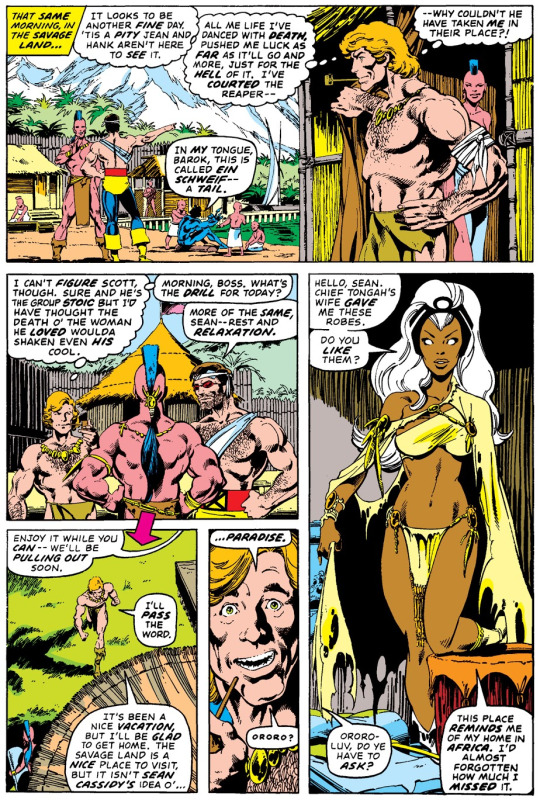
So, are we getting a sexy costume change with every new locale and/or story arc? What is this, Charmed? (X-Men 114)
The Savage Land plot is… kind of messy and confusing? First, Storm is attacked by Sauron (yay!) and he even hypnotizes Wolverine and uses his love for Jean against him (ew!), but as soon as Karl Lykos gains control again (boo!), he explains how he
Did not fall to his death;
Is suppressing his pterodactyl side (ain’t we all);
allied himself with the Savage Landers.
Then Ka-Zar, Marvel´s discount!Tarzan, explains how someone named Zaladane transformed a hapless innocent into Garruk, the Petrified Man, who is some sort of… living god? Who stopped some sort of interdimensional invasion by mending some sort of… portal rift? And then he set up shop in the swamp and built some sort of futuristic city? And he wants to enslave all of the natives of the Savage Land? And he built his city on the geothermal fissure that heats the Savage Land, so now the jungle is being choked out by snowy tundra?
Such a mess. And I know Zaladane gets important later, but, ugh, the socio-political tensions in the Savage Land is generally not what I’m here for.
One of the few Savage Land scenes I do like is also messy, but the emotional kind of messy. See, the X-Men on their part believe Jean and Hank are dead, and Scott takes it rather… lightly? When Storm confronts him about it, he confesses he does not mourn Jean as much as he thought he would, as if she were a different woman ever since they crash-landed the shuttle. Storm rejects this confession, always solidly in Jean’s camp, and basically tells Scott to man up. Scott has a point: Jean has changed and it’s not like people have fallen out of love for less, but there’s something to be said for Storm’s firm “for better or for worse”-argument. The scene ends unresolved, and I like that.
Anyway, there’s some X-Men fighting dinos and flying lizards, so there’s at least that. Oh, and Colossus develops a suddenly intense bond with a Savage Lander with a mohawk, which is a detail that becomes important later. Another significant detail?

There’s a lot of weight to that snikt, bub. (X-Men 116)
The implication is that Wolverine simply kills the guy in cold-blood. It’s a little weird that both Storm and Kurt are so okay with this, especially because Storm tries to save Garruk later. This, however, also marks an important direction in which they’re taking Wolverine, becoming the most ruthless of the X-Men.
In the end, Cyclops blasts the foundations of the citadel to smithereens, solving everyone’s problems and putting a neat bow on this tangled plotline. Also, all of a sudden? The X-Men are monthly again! (yay!) And they’ve upgraded from All-New, All-Different to Uncanny on the cover, though the name of the comic won’t officially change until issue 142.
Best new character: Like Hell I’m giving this to Weapon Alpha! So instead, it’s going to the two stylish, mohawked ladies who “show the island” to Piotr. (Again. They’ll be relevant later. Sort of.)
What to read: X-Men 109, for the denouement of the Phoenix Saga (or the first part thereof). The rest is rather inconsequential.
#x-men#x-men abridged#abridged x-men#cyclops#phoenix#storm#banshee#colossus#nightcrawler#professor x#lilandra neramani#Tony Dezuniga#chris claremont#john byrne#magneto#mesmero#sauron#savage land#moira mactaggart#warhawk
26 notes
·
View notes
Note
Hello! I have always believed that Michael needed better doctors and good treatment. He was simply billed as "Evil". Sometimes I think that at that time they were unaware or ignorant of mental illness, and that is why Michael did not recover. I wish it had been treated better. I would like to know your opinion about it ;v;
Oh, absolutely. Michael is a very tragic character, and what happened to him was almost entirely Loomis’ fault, secondarily the system and his parents’, and like onyl 0.8% his own. It’s true that mental health aid has historically been really bad in most places, and even today treatment and acceptance—even in specifically medical settings—tend to be abysmal. Of course people knew less than they do now about how psychological stuff works, but bias, cruelty, and superstition as well as a system that enables and even to degrees outright encourages that is to blame for the awful treatment people woth mental illnesses and personality disorders faced and continue to face, not just a lack of knowledge, and the history is really heavy and awful to look over. : ( It’s horrific some of the things doctors have done and do to people just trying to get help.
Like, in Michael’s case, we’ve had a name and understanding of psychosis since the 1800s. Canonically, by the time the poor kid was six years old, he was hearing voices telling him to do bad things to people. He told his parents, seeking help, and they did nothing to help him—just told him it was his imagination—despite knowing hos grandfather had suffered the same symptoms. If they had only taken him seriously and given him therapy and possibly medication too, Judith never would have died. (I am not goong to say it every time, but all this information is official canon) Michael’s reason for killing his family members is wanting the vocies talking to him to be quiet, because it’s agonizing. If you’ve ever had intrusive thoughts (stuff like “pull into oncoming traffic” or “break that and see what happens” and such that don’t actually compell or force you to do it at all, and are always things you as a person deeply do not want to do, but nevertheless are really annoying or distressing to hear in your head), imagine that cranked up to 1000, endless and constant, but from voices that seem to come from around you instead of in your head. Especially as a young child, with no understanding what is happening to you, this would be incredibly scary and distressing—doubly so when dismissed by your parents, whose sole job is supposed to be to love and protect you.
The voices say they’ll be quiet if Michael kills Judith, so Halloween night, he does. Important to note here Michael is recently six years old at the time, which developmental psych literally is not old enough to have a complete understanding what death itself is, let alone complex morality. You /cannot/ be evil at six, you simply don’t have a complex enough understanding of right and wrong or of consequence to /be/ evil. Also at this age, usually kids see death as a vague concept, but one that applies to people they don’t know only, not to them and their loved ones. In Halloween 1978, immediately after stabbing Judith, Michael looks away while he keeps doing it, and his breathing speeds up in a scared way. He barely looks at the body, and immediately goes down stairs to wait for his parents—probably for them to fix it—and does nothing to flee or hide what he’s done. He looks traumatized when they take his mask off. (Lots of little notes here like that Judith when she sees him seems annoyed but not very, and when he attacks her, tries to shield herself and call to him to stop, rather than fleeing or fighting back, which [appealing instead of fight or flight] is pretty exclusively something you only would use if attcked by someone you are on good terms with—I mean, Michael is six—if Judith had /tried/ to fight back, no way she would have died—so there’s less than nothing to indicate they had anything but a loving familial sibling relationship. But if I list all these I’m gonna launch into my six page Michael Myers meta so I will speed through the rest.)
Anyway! Sorry, I have many feelings. About...everything. Including Michael for sure. So, immediately after killing Judith, Michael stops talking. He also shows other psychosis and trauma readily recognized side effects, like catatonia, slowed movement. In Halloween 1978c Dr. Loomis claims he tried to treat Michael for eight years, then spent another seven trying to keep him locked up because he realized he was evil. This is a /blatant/ lie, as in film canon Loomis, by Michael’s review hearing I believe four months in? Six or less for sure, I believe it is four. Loomis has /already/ become convinced Michael is a demon in human form, faking his symptoms, and itching to kill again. The other doctors think Loomis is crazy, as does the other doctor who examines Michael, but they’re awful people so they let him stay Michael’s doctor anyway, even though they refuse to move him to Litchfield maximum security. By this time only a few months in, Loomis is canonically also threatening the six year old in his care and constantly telling him he is an evil being who wants to get out and terrorize again. (Also, I will die enraged the sentance Michael gets for killing Judith is to remain locked in solitary in a sanitorium for /15/ years, until he turns 21, at which point he will be tried as an adult for murder??? The fuck?? You CANNOT charge a 6 year old’s crime in adult court! ‘Tried as an adult’ is meant for like, when a 17 year old dismembers their family and eats them! It’s for particularly heinous crimes, committed by someone /very/ close to being legally an adult, and that /only/. The idea of waiting fifteen years to try someone as an adult for something done at age six is laughable and sick).
Okay this is already long, I get carried away rip. Uhhh, anyway, yeah. In Smith’s Grove, Michael is visited by mom and Laurie once, then never sees any of his family again, because his dad hates him and forbids the others—finds out because Laurie is four and talks that they went /one/ time, and physically beats four year old Laurie for mentioning his name until she trauma blocks out ever having had a brother. From then on, Michael spends /fifteen/ years and all the dest of his developmental stages of childhood in a sanitorium with Dr. Loomis—a man who on wild religious superstition grounds assumes by his own admission /on sight/ that Michael is evil, and no other human contact. According to canon, Michael spends at least four hours of /every/ day with Loomis, his /only/ human contact, who threatens him, promises to stop him, and endlessly barrages him with “You’re evil, you’re not human, you want to kill again, I /will/ stop you,” and nothing else. He also canonically keeps Michael overdosed on a type of antipsychotic that, while a fine drug if used normally, if overdosed can deeply worsen symptoms, and can cause permanent brain damage.
Honestly, if a six year old is exposed yo major trauma, none of their issues are explained, legitimized, or believed, and almost all of their developmental stage is spent with endless voices they don’t know the cause of suggesting murder and violence, one human being and authority figure telling them over and over and over for fifteen years with no other constant in their life or human contact period that they are a demon in human form who wants to kill and is /going/ to do so again...? How else was that story ever going to end? I’ve said it before, but that’s beyond conditioning; it’s lab growing a human child to one day walk out and murder Laurie Strode with a large kitchen knife.
I stand by Halloween is a greek tragedy more than a slasher, and Michael and Laurie are both victims. He’s the Asterios, she’s the Ariadne. Loomis the Minos, the real villain. (Or the Poseidon choose your poison).
Anyway, I 100% agree! If he had just gotten help from his parents, Judith would have never died. If he’d had good doctors, none of the events of 1978 would have come to pass, or anything after it. Loomis single-handedly causes the deaths in 1978 himself through years of cruelty, and bigoted bias towards a small child in his care who needed his help, not his abuse, but he chose to break as much as he possibly could despite his responsibilities as a doctor, an adult, and a human.
If you’re interested, I did a canon-deep-dive character study short story on Michael on AO3! Halloween is such a sad story but it’s fascinating. God, poor Michael and Laurie deserved so much better than they got. It’s a testament to Michael’s character that even after 15 years of Dr. Loomis, he really only kills his intented target(s) in search of quiet from the voices, and anyone who sees him/would be a threat, and not other people. Makes no attempt to kill any of the kids in Halloween 2018, and only kills Bob when he literally opens the door to his hiding spot and Michael is found and Bob becomes a threat to him. In H20, after Michael has had 20 years on his own, you get arguably the least brutal Michael, who intentionally passes on killing the mother and child, and the security guard he walks right past, because they don’t see him and thus he doesn’t /have/ to. Halloween II is less intentionally avoiding, but even then he still does the same multiple times too, like with the old lady making a sandwich, or the scene in the incubator room. Anyway he desevered better fuck Loomis all my homies hate Loomis.
#ask#anonymous#michael myers#halloween#halloween 1978#halloween II#Halloween H20#Halloween 2018#note: Michael is written /very/ differenly in the different timelines. different writers took complrtely dofferent approaches to hin as a#person. and his motives. so unless I state otherwise I am always talking exclusively about the version of Michael from the H20. 2018. & DbD#timelines. since those are all largely the same character. unlike the 3-4 RZ and resusrection or the novelization etc#they’re seperate universes w different canons. i am only really interedted in core/OG canon and its offshoots#its /direct/ offshoots haha#laurie strode#sam loomis#Isolation (fic)#Isolation#meta#michael myers meta#long post#me: I am not gonna do the six page breakdown ima do an overview#me: doesn’t do the six pages but damn well doesn’t do the short version either#i can’t help it you found an intense passion topic
66 notes
·
View notes
Text
Smokey brand Movie Reviews: Super Green
The Green Knight s finally out and i can see it without having to wait a month and a half! I thank A24 for this rather quick turnaround because this thing has been on my radar fr what seems like forever! I’ve written about this before but A24 is my favorite studio releasing content. Neon is a close second and Netflix is making a real charge, but A24 releases classics. Some of my all-time favorite films are A24 products. Ex Machina, Hereditary, Under the Skin, The VVitch, Uncut Gems, Zola, Midsommar, Lady Bird, Eighth Grade, The Lighthouse, High Life, The Monster, Enemy, Climax, Room, The Killing of a Sacred Deer, The Disaster Artist, and Under the Silver Lake have all impressed in one for or another, all of them A24 offerings. This studio is f*cking amazing and i cannot sing it’s praises enough. They’ve been around for less than a decade, A24 was founded in August of 2012, and they’re brought this level of quality consistently. The Green Knight has all of the workings to slide right into my all-time list, just like Ex Machina and Hereditary did before it. Let’s see if i really love it as much as i think i will.
The Exceptional
The first thing that hits you is how f*cking gorgeous this film is. Seriously, i was immediately captivated by that opening scene with Gawain rushing for Mass. It definitely opens up as the film progresses and you are treated to one of the most visually striking films of the year. This movie could give Denis Villeneuve, Ari Aster, or Robert Eggers a run for their money. Seriously, you can frame several shots in a museum and no one would know the difference between that and the Van Gophs on display.
I r0aely mention this but it’s absolutely necessary that i do in this particular review because it was just that memorable. The sound design made this film. I’m not talking about music choice or score, but the actual sound effects for specific scenes. That sh*t was some of the tightest I've ever hear on a film and it really added to the overall experience. Just the way the Green Knight creaked and popped as he moved was more than enough to get this mention but there is so much ore than just that. I hate that i had to see this at home because, f*ck, this thing would have sounded like god in a proper theater.
I mentioned that you can frame these shots in a museum before and a lot of that shine belongs to the cinematography. The shots chosen for this film are breathtaking. I imagine a lot of that has to do with location but even the scenes filmed in dank castles and murky bogs popped with that same, meticulous, shot composition and it really gave those scenes life. The were ties when my jaw dropped at the majesty of a scene. The one with the giants immediately comes to mind. Like, f*ck, was that beautiful to witness.
In that same breath, you have to know when to pull back. Editing is just as important to a film as anything else and The Green Knight is cut with a precision I've rarely seen. This thing has no fat whatsoever. It presents to you exactly what you need and little else. I love that. I love that this film has a story to tell and it tells it with extreme prejudice. These cuts were made with intent. That’s rare nowadays.
I also have to give a nod to the use of color and lighting. Again, it’s not something i ever really focus on but goddamn is it necessary for this review. Light plays a very important role in how this story was told. Certain scenes absolutely need it and others are perfectly accentuated by it. It takes a deft hand to juggle such a nuanced aspect of film and The Green Knight has done that the best this year. So far.
This film has a very real, very potent, atmosphere. It’s not tension, not like Uncut Gems of Good Times, but there is this unrelenting sense of dread that runs through this entire film. It’s measured and restrained but it’s always there. I appreciate that. For a film to illicit such emotion out of me is testament to the mastery of it’s visionary.
All of the praise I've given to the technical aspects of this film would be for naught if i didn’t recognize the director, David Lowery. This dude is fast climbing the list of my favorite directors. I actually listed bunch above but, after seeing what he’s gone with this film, dude is really making a case for himself. He did the Pete’s Dragon remake which i hear as pretty good, and A Ghost Story but i haven’t seen either. Not really my cup of tea. But if they’re as good as The Green Knight, i might have to revisit that thought because, holy sh*t, this dude can direct the f*ck out of a film.
The writing is on point. I legit hesitated to put this on here because it is the weakest aspect of everything else in this film but that is misleading. The writing is exceptional. There is no way this film could be as good as it is, if the script was dog sh*t. The material given to these performers had to the top tier in order for them to give the performances they did and and they definitely f*cking did that!
This whole cast really f*cking delivered. Sarita Choudhury as Mother and Sean Harris as the King were easily the best of the supporting cast but everyone else brought that same energy. Joel Edgerton, Kate Dickie, and Barry Keoghan, all deliver powerful performances. Hell, this is the best I've ever seen Erin Kellyman act and i have to give a lot of credit to the overall quality of this cast delivered. That said, there are three individuals who put everyone else to shame and i say that knowing exactly how much praise i just heaped upon them all.
Alicia Vikander comes in and delivers on two roles, Essel and the Lady. This isn’t surprising at all because she always delivers. I’m never disappointed by her performances. Admittedly, i haven’t seen many but that’s because she is very particular about the characters she signs on to portray. That said, it’s weird the two performances she’s done that immediately jump out to me, are both with A24 films. Her Eva in Ex Machina, and that film in general, is what made me even take notice of both her and A24 as a studio. Here we are, seven years later, and she’s still blowing my mind. F*cking exceptional.
Ralph Ineson is almost unrecognizable in the Green Knight make-up but the second he opens his mouth, you immediately recognize that gravitas. There is a weight to this character and you f*cking feel it with every move Ineson makes. Dude isn’t in it much but the scenes he does appear in are absolutely stolen by this big, green, maestro of his craft.
More than anyone, this is Dev Patel’s film. This dude is a great actor but it’s rare someone gets a part where they can really bite into the content but that is not the case with this role. No, sir, this sh*t was tailor made for Patel and he definitely digs right the f*ck in. His Sir Gawain is just as good as his Jamal Malik from Slumdog, if not better. Seriously, this film would be nothing without Patel. As outstanding as every other aspect that i gushed about in this brilliant goddamn film, the very best is Dev Patel’s performance. Seriously, that sh*t, alone, is worth the watch.
The Verdict
The Green Knight is f*cking exceptional and exceeded all of my expectations. This year long wait was more than worth. It's the best film of the year so far, leap-frogging into my top twenty all-time and I've seen thousands of films. This thing is a masterpiece on all levels. Narrative, plot, lighting, performances, sound design, composition, editing, score; It's the closest thing to a technically perfect film I've seen in quite some time. If Dev Patel doesn't get an Oscar nod for this, there is no justice in the world because he f*cking carries this movie. Patel is easily the strongest force driving this incredibly compelling watch, but Alicia Vikander, Erin Kellyman, Sarita Choudhury, Ralph Ineson, Sean Harris, Kate Dickie, and Barry Keoghan all match that energy with f*cking gusto. I was absolutely mesmerized by the way these absolute masters in their craft, embodied and gave their respective characters life, particularly Vikander. She never disappoints.
The only issue I see that would hinder someone actually getting into this film is the fact that it's a little long in the tooth. You never really feel it, as long as you buy into the fact it's a character study and not a high concept fantasy film filled with dragons and sh*t. If you think Michael Bay and Zack Snyder are the pinnacle of cinematic excellence, pass on this. You won't make past the first tn minutes. Also, make better life choices. No, this is about Gawain and it never deviates from that core drive. Weird sh*t happens, sure, but it's nothing as fantastical as Smaug or a Balrog. Even so, this f*cking movie kept me glued to the edge of my seat. I loved every second of it and cannot sing it's praises enough. My only regret is that I didn't get to see it in a proper theater. This f*cker would have been a real experience to see on a proper cinema screen, especially that shot with the giants. The Green Knight is outstanding and deserves all of the praise it's gotten and so much more.
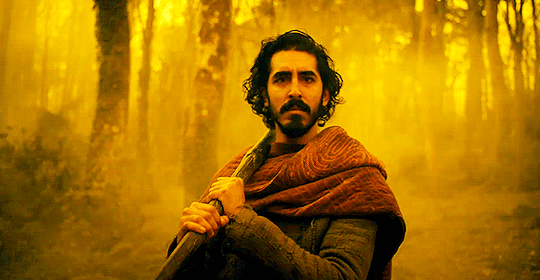
8 notes
·
View notes
Note
Hey, d'you have any French book recs? I'm trying to work on my French, and rn I have downloaded one of my favourite book series' French translations, but I figured maybe books already written in French might work better? Also have you read the Ranger's Apprentice series? 1/2
RA's def flawed - the books' narration does like to point bright arrows at the protagonists' intelligence, and the last few books def have the tone of 'old white man trying to write feminism', although at least he's trying? - and it's aimed more to the younger side of YA, but it is still a very fun series, and I can ignore the flaws fairly easily, at least partly due to nostalgia? This rather long lol but I'm wordy.
I'll start with the second question: no, although every time the series is brought up I have to check the French title and go "oh, right, I've seen these books in stores". But I've never purchased or read them. It sounds like something I probably would have enjoyed as a teen but I just missed the mark, and these days I'm trying to drown myself in queer books, so that probably isn't happening.
As for your first question, geez, I haven’t read a French book in years, so this is gonna skew middle grade/YA, though that may not be so bad if the point is to learn the language. I will also say that as a result, these may read a little outdated.
I'll put it under a cut, even if Tumblr has become really bad with correctly displaying read mores. Sorry, mobile crowd.
It's also likely that old readers of the blog will have seen me talk about most of these. I don't feel like going through old posts.
One last thing: while I was curating this list I took the time to make a Goodreads shelf to keep track of those.
The Ewilan books by Pierre Bottero
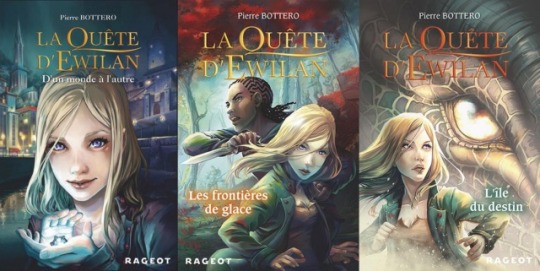
(It's a testament to how long ago I read these books that these are not the covers of the edition I own, and I can't even find those on Google. I'm settling for a more recent cover anyway since it'll make it easier to find them, presumably)
There are at least three trilogies (that I know of) set in the same world.
The first trilogy is essentially an isekai (so, French girl lands in parallel fantasy world by accident) with elements of chosen one trope, though I find the execution makes it worth the while anyway.
The second trilogy is a direct sequel, so same protagonist but new threat, and the world gets expanded.
The third one is centered around a supporting characters from the previous books, and the first couple of books in it are more her backstory than a continuation, though the third one concludes both that trilogy and advances the story of the other books as well.
Notably these books have a really fun magic system where the characters "draw" things into existence. It's just stuck with me for some reason.
A bunch of stuff by Erik L'Homme
I have read a lot of this man's books, starting with Le Livre des Etoiles.
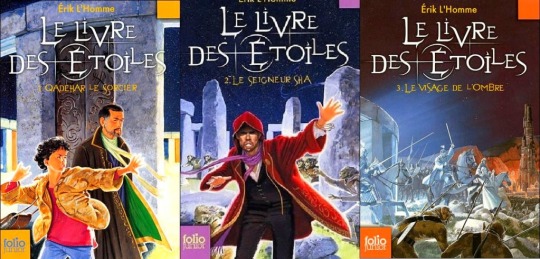
They also skew towards the young end of YA, arguably middle grade, I never bothered to figure out where to draw the line. They're coincidentally also using the premise of a parallel world to our own (and yes, connected to France again, the French are just as susceptible of writing about their homeland), but interestingly are set from the point of view of characters native to the parallel world.
It also has a very unique magic system, this one based on a mix of a runic alphabet and sort-of poetry. I'll also say specifically for these books that the characters stuck with me way more than others on this list, which is worth mentioning.
This trilogy is my favorite by Erik L'Homme, but I'll also mention Les Maîtres des brisants, which is a fantasy space opera with a pirate steampunk(?) vibe. I think it's steampunk. I could be mistaken. But it's in that vein. It's also middle grade, in my opinion not as good, but it could just be that it came out when I was older.
Another one is Phaenomen, which was a deliberate attempt at skewing older (though still YA). This one is set in our (then-)modern world and centers a group of teens who happen to have supernatural powers. I guess the best way to describe it is a superhero thriller? If you take "superhero" in the sense of "people with individualized powers", since they don't really do a lot of heroing.
...I really need to brush up on genre terminology, don't I.
The Ji series by Pierre Grimbert
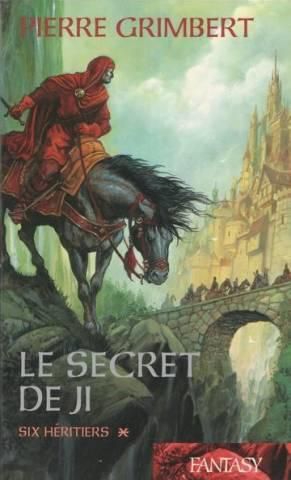
This one is actually adult fantasy, though it definitely falls under "probably outdated". It is very straight, for starters, and I'd have to give it another read to give a more critical reading of how it handles race (it attempts to do it, and is well meaning, but I'm not sure it survives the test of time & scrutiny, basically).
If I haven't lost you already, the premise is this: a few generations ago, a weird man named Nol gathered emissaries from each nation of the world and took them to a trip to the titular Ji island. Nobody knows what went down here, but now in the present day, someone is trying to kill off all descendants from those emissaries, who are as a result forced to team up and figure out what's going on.
I'm not going to spoil past that, though I will say it has (surprise) a really unique magic system! I guess you can start to piece together what my younger self was interested in. Which, admittedly, I still am.
Once again, this one also has a strong cast of characters, helped by rich world building and the premise forcing the characters to come from many different cultures (though, again, I can't vouch for the handling of race because it's been too long).
The first series is complete by itself, though it has two sequel series as well, each focusing on the next generation in these families. Because yes, of course they all pair up and have kids. Like I said: very straight.
A whole lot of books by Jean-Louis Fetjaine
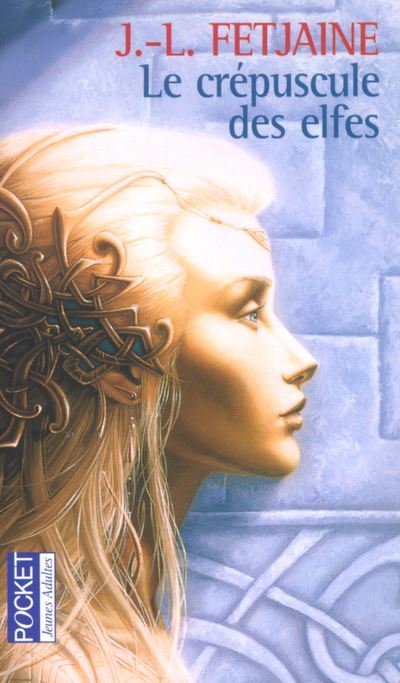
OFetjaine is a historian, and I guess he's really interested in Arthurian mythos especially, because he loves it so much he's written two separate high fantasy retellings of them! I'm not criticizing, mind you, we all need a hobby.
The former, the Elves trilogy (pictures above) is very traditional high fantasy. Elves, dwarves, orcs, a world which is definitely fictionalized with a pan-Celtic vibe to it. The holy grail and excalibur are around, but they're relics possessed by the elves and dwarves with very different powers than usual. Et cetera.
Fetjaine also really loves his elves (as the titles might imply), and while they're not exactly Tolkien elves, there's a similar vibe to them. If you like Tolkien and his elf boner, you'll probably like this too. And conversely, if that turns you off, these books probably also won't work for you.
This series also has a prequel trilogy, centered around the backstory of one of the main characters. I...honestly don't remember too much about it, but I liked it, so, there you go, I guess.
I said Fetjaine did it twice. The other series is the Merlin duology, which, as the title implies, is a retelling of Merlin's story. Note that Merlin is also in the other trilogy, but it's a different Merlin; like I said, completely different continuities and stories.
This one is historical fantasy, so it's set in actual Great Britain, and Fetjaine attempts to connect Arthur to a "real" historical figure...but, you know, Merlin is also half-elf and elves totally exist in Brocéliande, so, you know. History.
Okay, that's probably enough fantasy, let me give some classics too.
L'Arbre des possibles et autres histoires - Bernard Werber
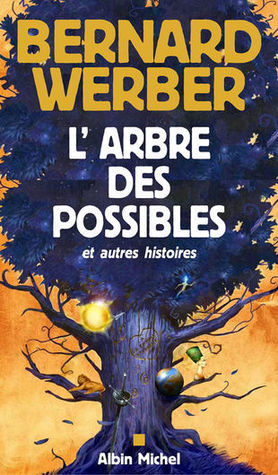
Bernard Werber is a pretty seminal author of French sci-fi and I should probably be embarrassed that the only book of his that I read was for school, but, it is a really good one, so I'll include it anyway.
It's a novella collection, and when I say "sci-fi" I want to make it clear that it's very old school science fiction. It's more Frankenstein or Black Mirror than Star Trek, what we in French call the anticipation genre of science fiction: you take one piece of technology or cultural norm and project it into the future.
It has a pretty wide range of topics and tones, so it's bound to have some better than others. My personal faves were Du pain et des jeux, where football (non-American) has evolved into basically a wargame, and Tel maître, tel lion, where any animal is considered acceptable as a pet, no matter how absurd it is to keep as a pet. They're both on a comedic end, but there's more heartfelt stuff too.
L'Ecume des Jours - Boris Vian
(no cover because I can't find the one I have, and the ones I find are ugly)
This book is surrealist. Like, literally a part of the surrealist movement. It features things such as a lilypad growing inside a woman's lungs (and, as you well know, lilypads double in size every day, wink wink), the protagonist's apartment becoming larger and smaller to go with his mood and current financial situation, and more that I can't even recall at the moment because remembering this book is like trying to remember having an aneurysm.
It is also really, really fun and touching. Oh, and it has a pretty solid movie adaptation, starring Audrey Tautou, who I think an international audience would probably recognize from Amelie or the Da Vinci Code movie.
I don't really know what else to say. It's a really cool read!
Le Roi se meurt - Eugène Ionesco
Ionesco is somewhat famous worldwide so I wasn't even sure to include him here. He's a playwright who wrote in the "Theater of the Absurd" movement, and this play is part of that.
The premise of this play is that the King (of an unnamed land) is dying, and the land is dying with him. I don't really know what else to say. It's theater of the absurd. It kind of has to be experienced (the published version works fine, btw, no need to track down an actual performance, in my humble opinion).
The Plague - Albert Camus
You've probably heard of this one, and if you haven't, let me tell you about a guy called Carlos Maza
youtube
I'm honestly more including this book out of a sense of duty. The other three are books I genuinely liked and happen to be classics. This book was an awful read. But, um. It's kind of relevant now in a way it wasn't (or didn't feel, anyway) back in 2008 or 2009, when I read it. And I don't just mean because of our own plague, since Camus's plague is pretty famously an allegory for fascism, which my teenage self sneered at, and my adult self really regrets every feeling that way.
Okay, finally, some more lighthearted stuff, we gotta talk about the Belgian and French art of bande dessinée. How is it different from comic books or manga? Functionally, it isn't. It really comes down more to what gets published in the Belgian-French industry compared to the American comics industry, which is dominated by superheroes, or the Japanese manga industry, which, while I'm less familiar with it, I know has some big genre trends as well that are completely separate.
The Lanfeust series - Arleston and Tarquin
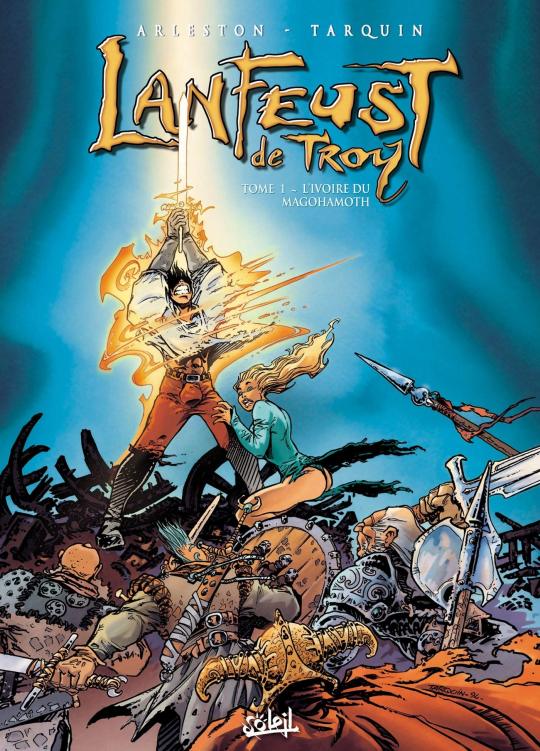
This is a YA mega-series, and I can't recommend all of it because I've lost track of the franchise's growth. Also note that I say "YA", but in this case it means something very different from an American understanding of YA. These books are pretty full of sex.
No, when I say YA I mean it has that level of maturity, for better or worse. The original series (Lanfeust de Troy) is high fantasy in a world where everyone has an individual magical ability but two characters find out they're gifted with an absolute power to make anything happen, and while it gets dark at times, it's still very lighthearted throughout, and the humor is...well, I think it's best described as teen boy humor. And it has a tendency to objectify its female characters, as you'll quickly parse out from the one cover I used here or if you browse more covers.
But still, it holds a special place in my heart, I guess. And on my shelves.
The sequel series, Lanfeust des Etoiles, turns it into a space opera, and goes a little overboard with the pop culture reference at times, though overall still maintains that balance of serious/at times dark story and lighthearted comedy.
After that the franchise is utter chaos to me, and I've lost track. I know there was another sequel series, which I dropped partway through, and a spinoff that retold part of the original series from the PoV of the main love interest (in the period of time she spent away from the main group). There was a comedy spin-off about the troll species unique to this world, a prequel series, probably more I don't even know exist.
Les Démons d'Alexia
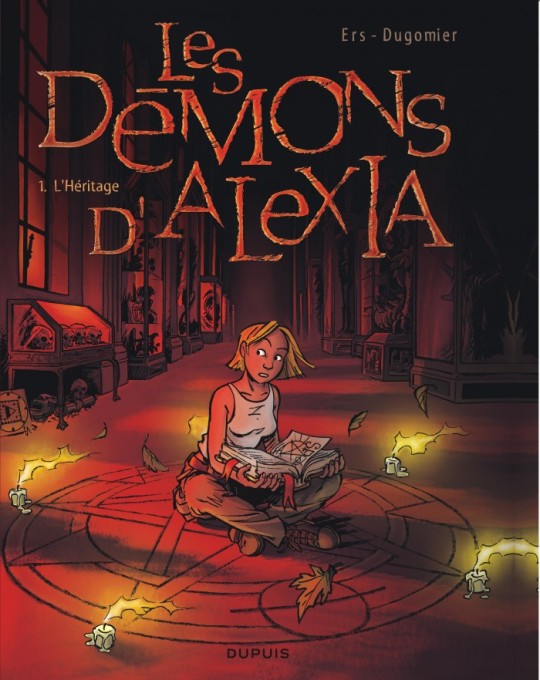
Something I can probably be a little less ashamed of including here.
Some backstory here. The Editions Dupuis are a giant of the Belgian bande dessinée industry, and for many, many years I was subscribed to their weekly magazine. That magazine was (mostly) made up of excerpts from the various books that the éditions were publishing at the time; those that were made of comic strips would usually get a couple pages of individual scripts, while the ongoing narratives got cut into episodes that were a few pages long (out of a typical 48 page count for a single BD album). Among those were this series.
For the first few volumes, I wasn't super into this series, probably because I was a little too young and smack dab in the middle of my "trying to be one of the boys" phase. But around book 3 I got really invested, to the point where I own the second half of the series because I had canceled by subscription by then but still wanted to know more.
Alexia is an exorcist with unusual talents, but little control, who's introduced to a group that specializes in researching paranormal phenomena, solving cases that involve the paranormal, that kinda stuff.
As a result of the premise, the series has a pretty slow start since it has to build up mystery around the source of Alexia's powers, but once it gets going and we get to what is essentially the series' main conflict, it gets really interesting.
Plus, witches. I'm a simple gay who likes strong protagonists and witches.

Murena
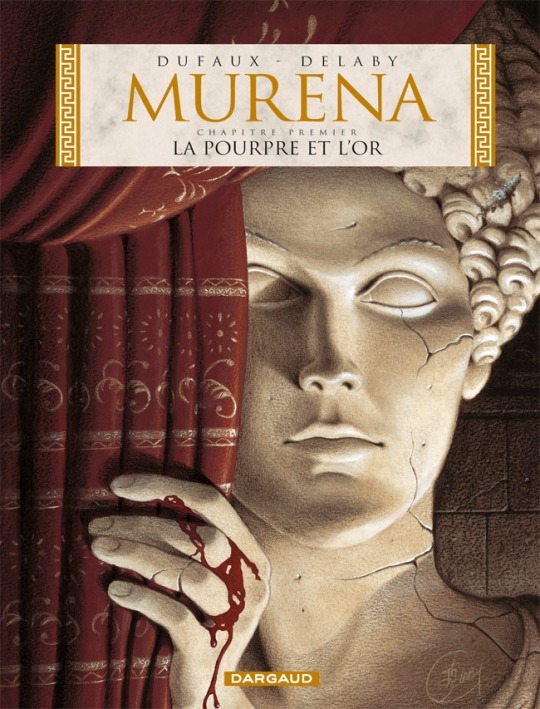
There was a point where my mtyhology nerdery led me to look for more stuff about the historical cultures that created them, and so I'd be super into stuff set in ancient Rome (I'd say "or Greece or Egypt" but let's face it, it was almost always Rome).
Murena is a series set just before the start of Emperor Nero's rule. You know, the one who was emperor when Rome burned, and according to urban legend either caused the fire or played the fiddle while it did (note: "fiddle" is a very English saying, it's usually the lyre in other languages). He probably didn't, it probably was propaganda, but he was a) a Roman Emperor, none of whom were particularly stellar guys and b) mean to Christians, who eventually got to rewrite history. So he's got a bad rep.
The series goes for a very historical take on events, albeit fictionalized (the protagonist and main PoV, the titular Lucius Murena, is himself fictional) and attempts to humanize the people involved in those events. Each book also includes some of the sources used to justify how events and characters are depicted, which is a nice touch.
It's also divided in subseries called "cycles" (books 1-4, 5-8 and the ongoing one starts at 9). I stopped after 9, though I think it's mostly a case of not going to bookstores often anymore. Plus it took four years between 9 and 10, and again between 10 and 11. But the first eight books made for a pretty solid story that honestly felt somewhat concluded as is, so it's a good place to start.
#pierre bottero#la quête d'ewilan#erik l'homme#le livre des étoiles#phaenomen#pierre grimbert#le secret de ji#jean louis fetjaine#la trilogie des elfes#bernard werber#l'arbre des possibles#boris vian#l'écume des jours#le roi se meurt#eugène ionesco#albert camus#la peste#the plague#lanfeust#arleston#tarquin#Les démons d'alexia#ers#dugomier#murena#dufaux#delaby#ask#anonymous#st: other posts
24 notes
·
View notes